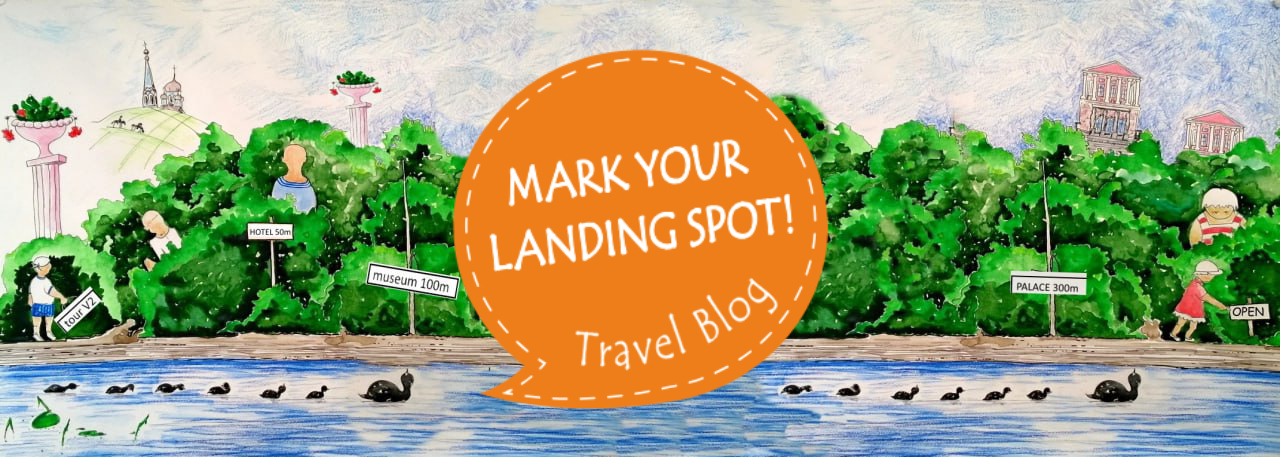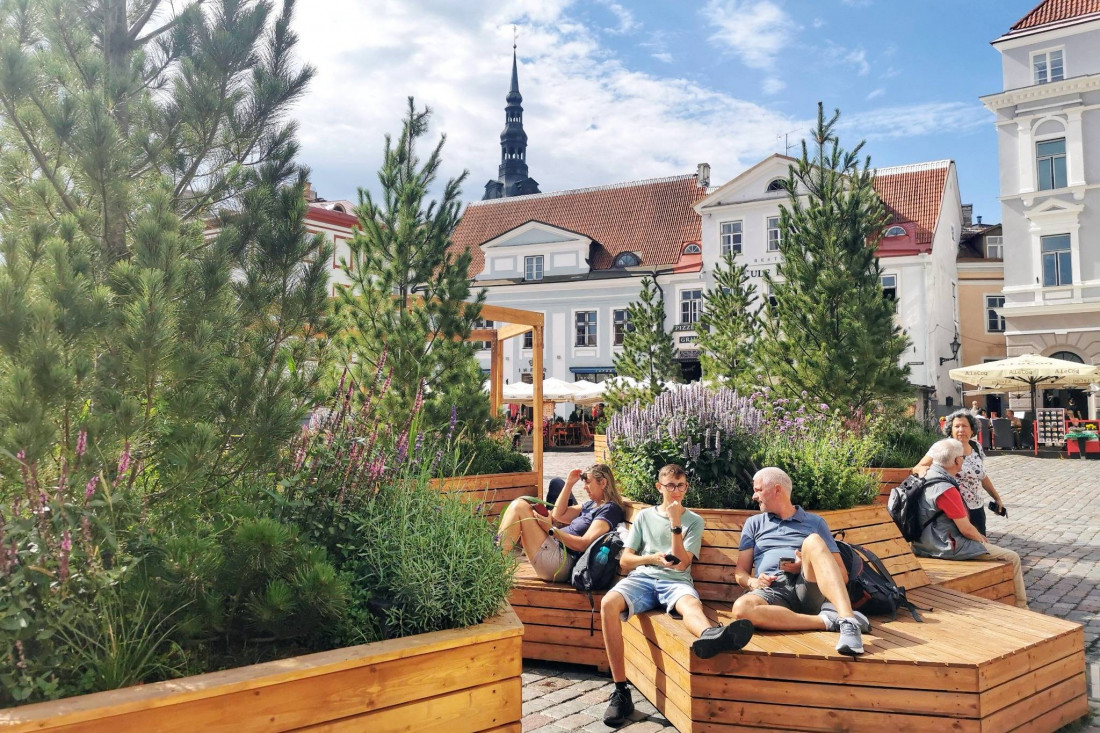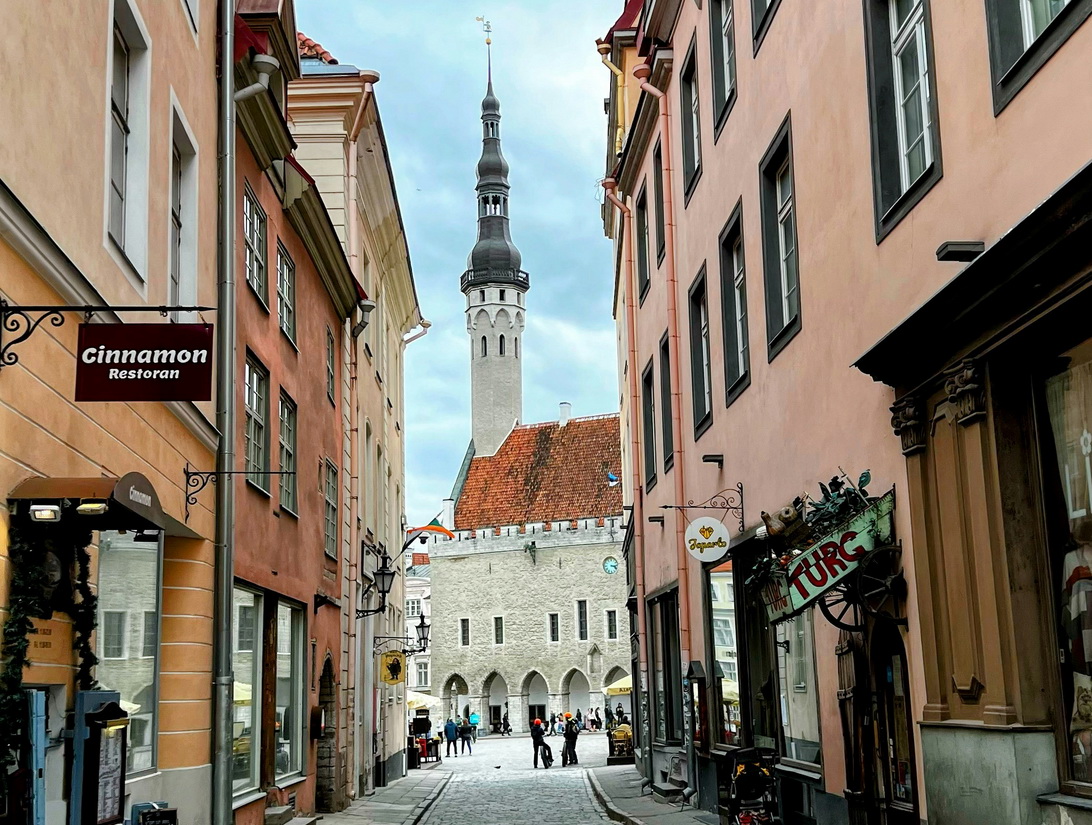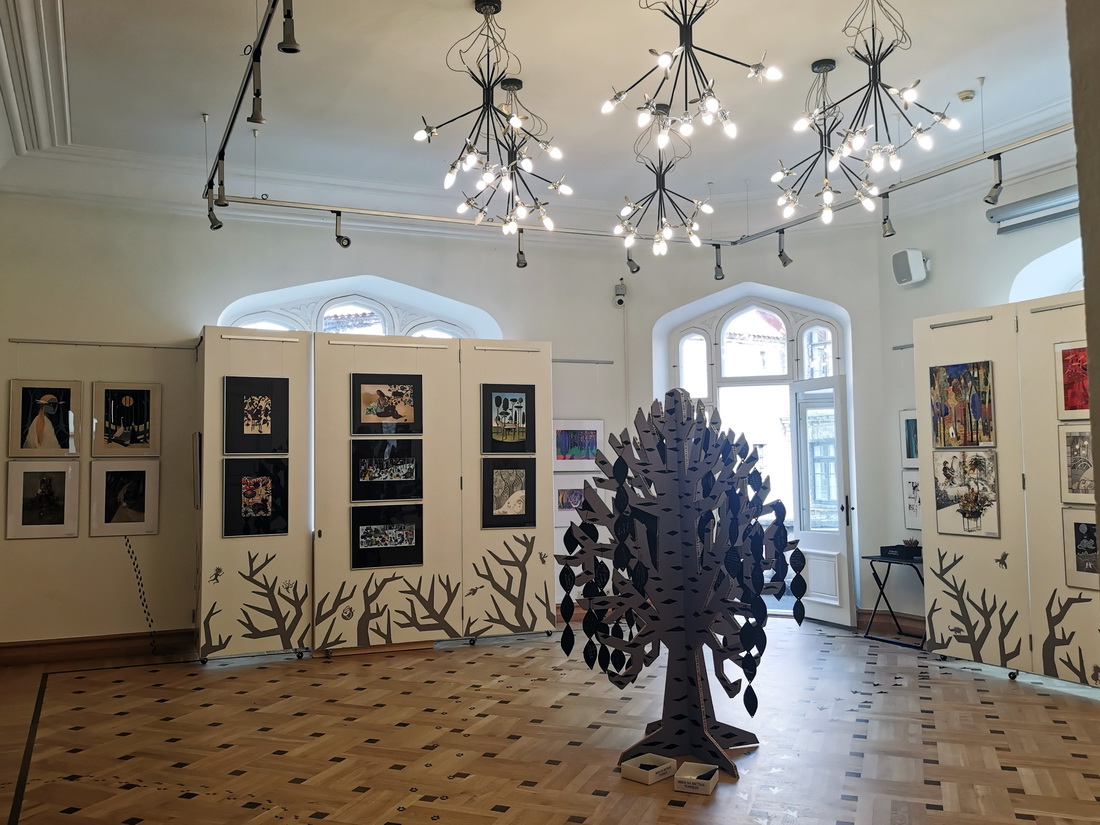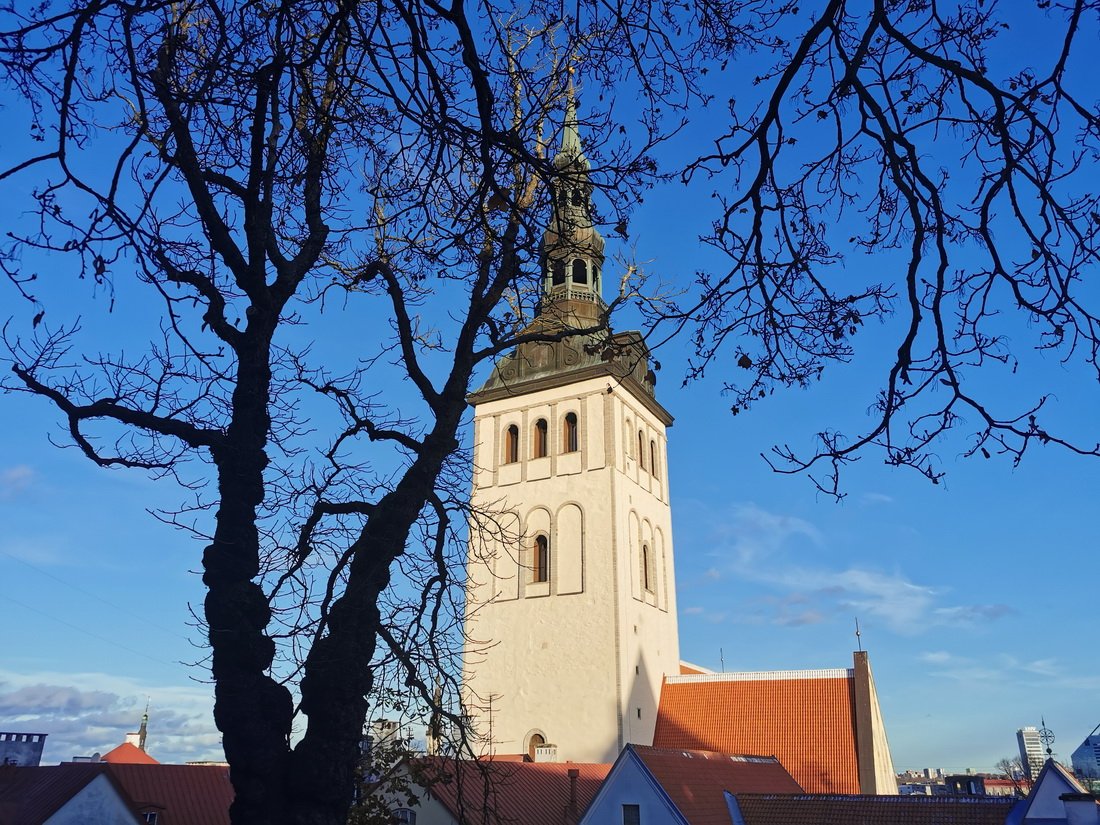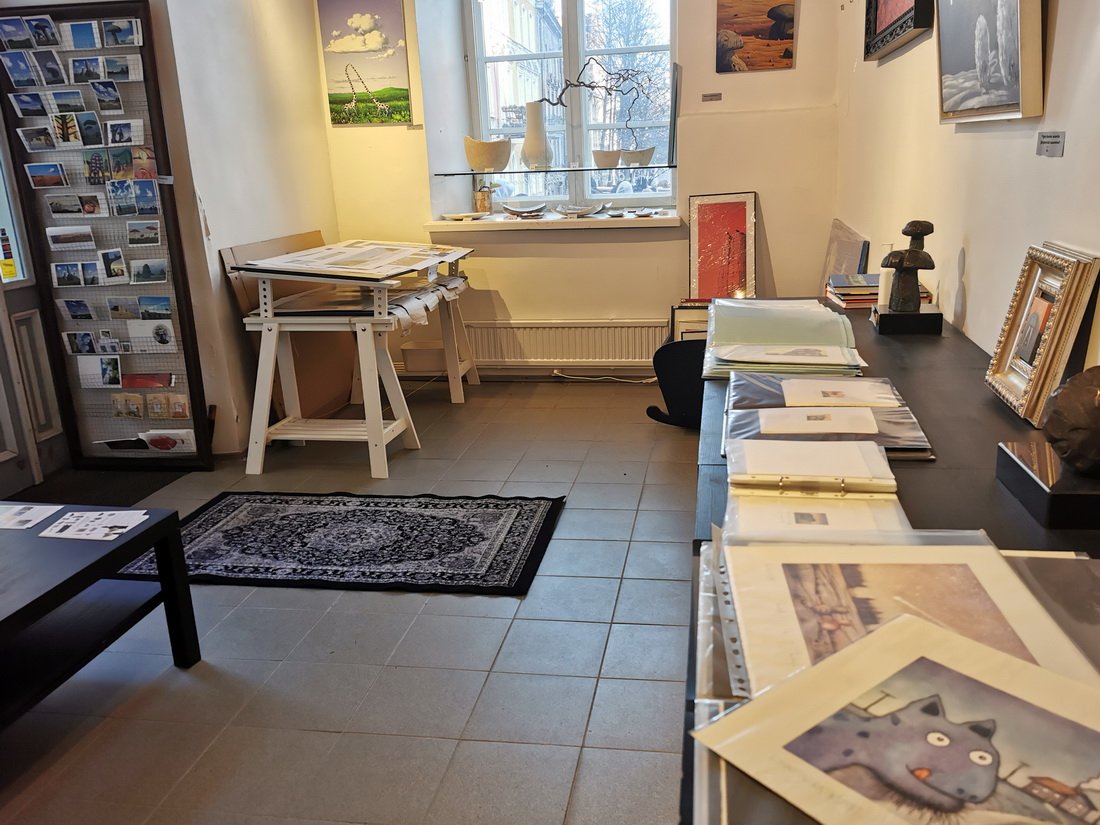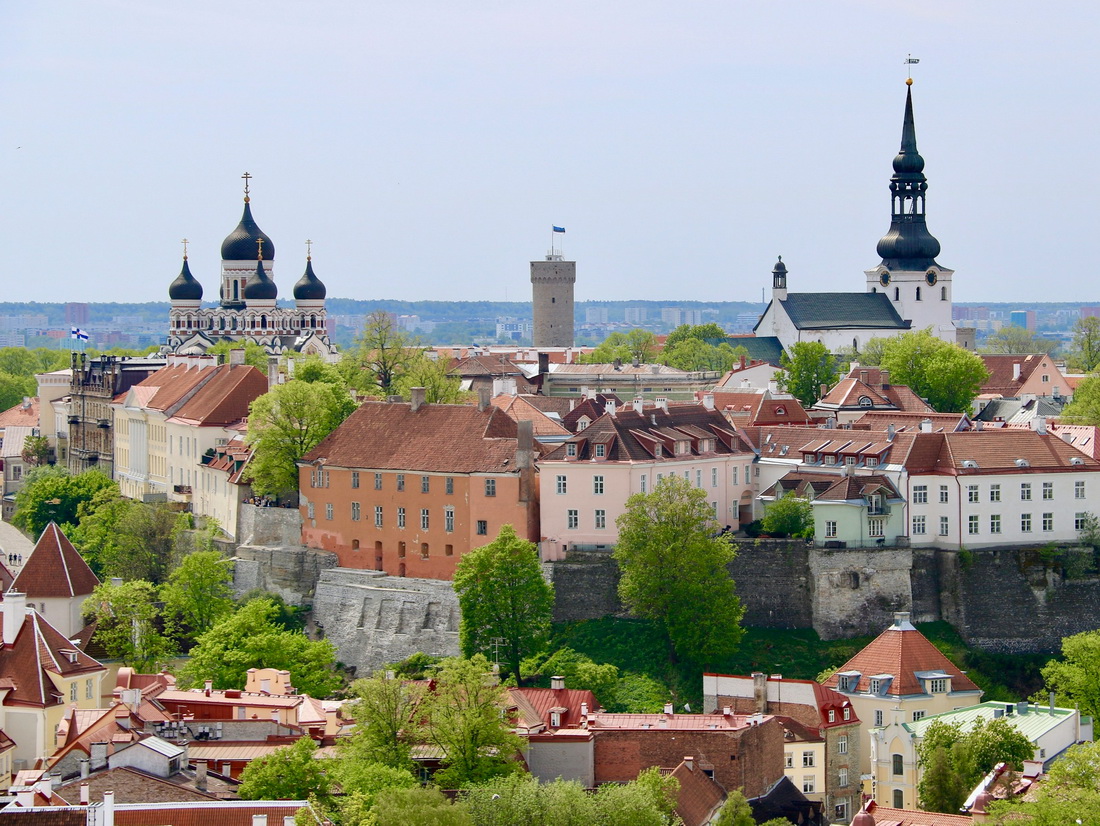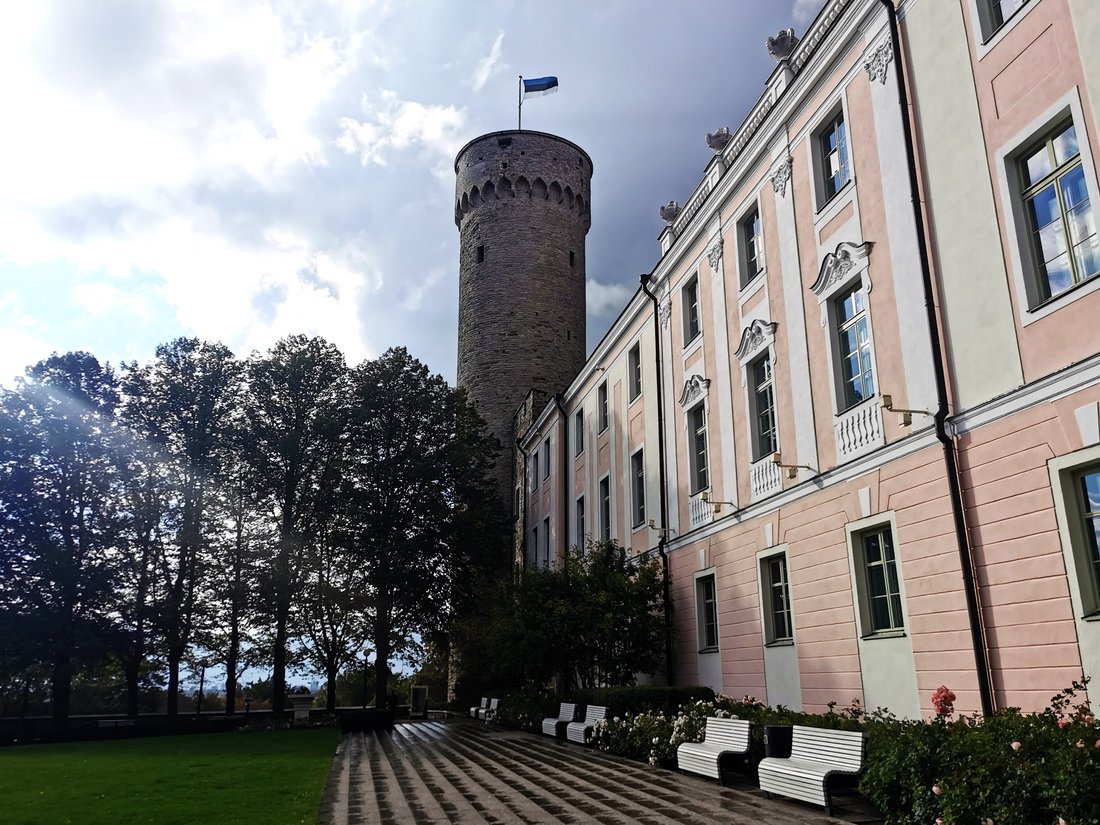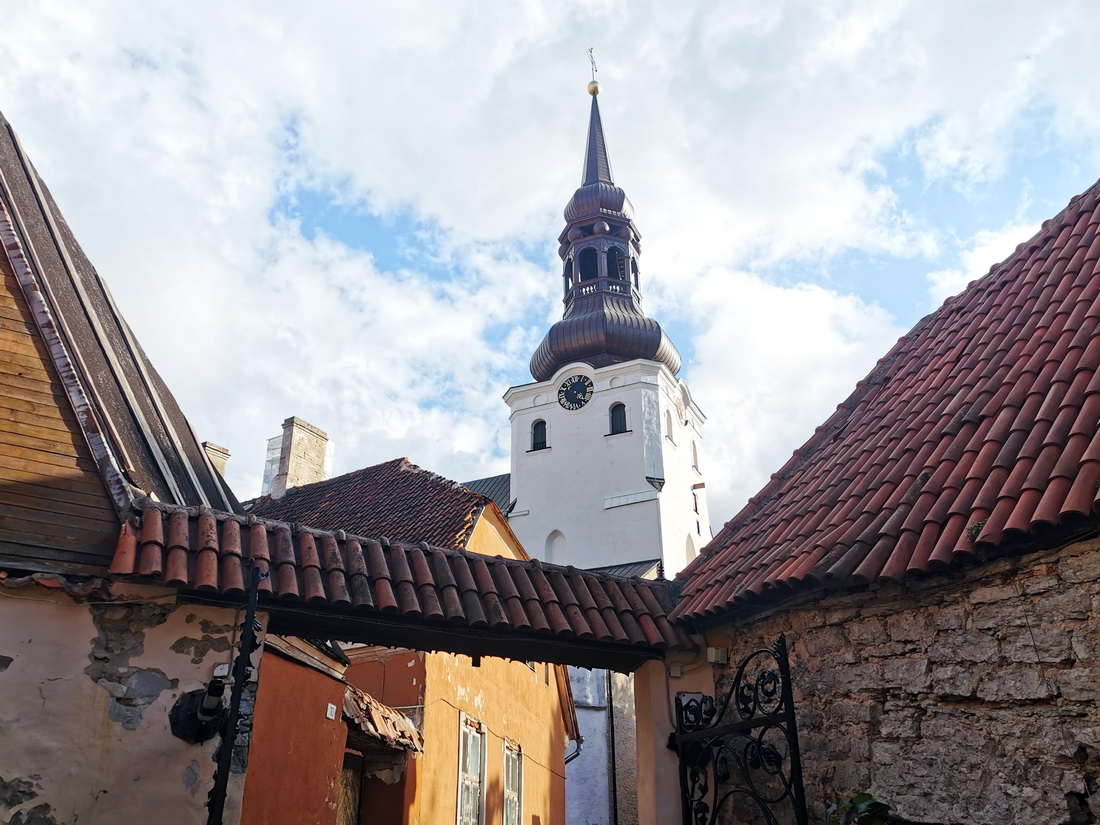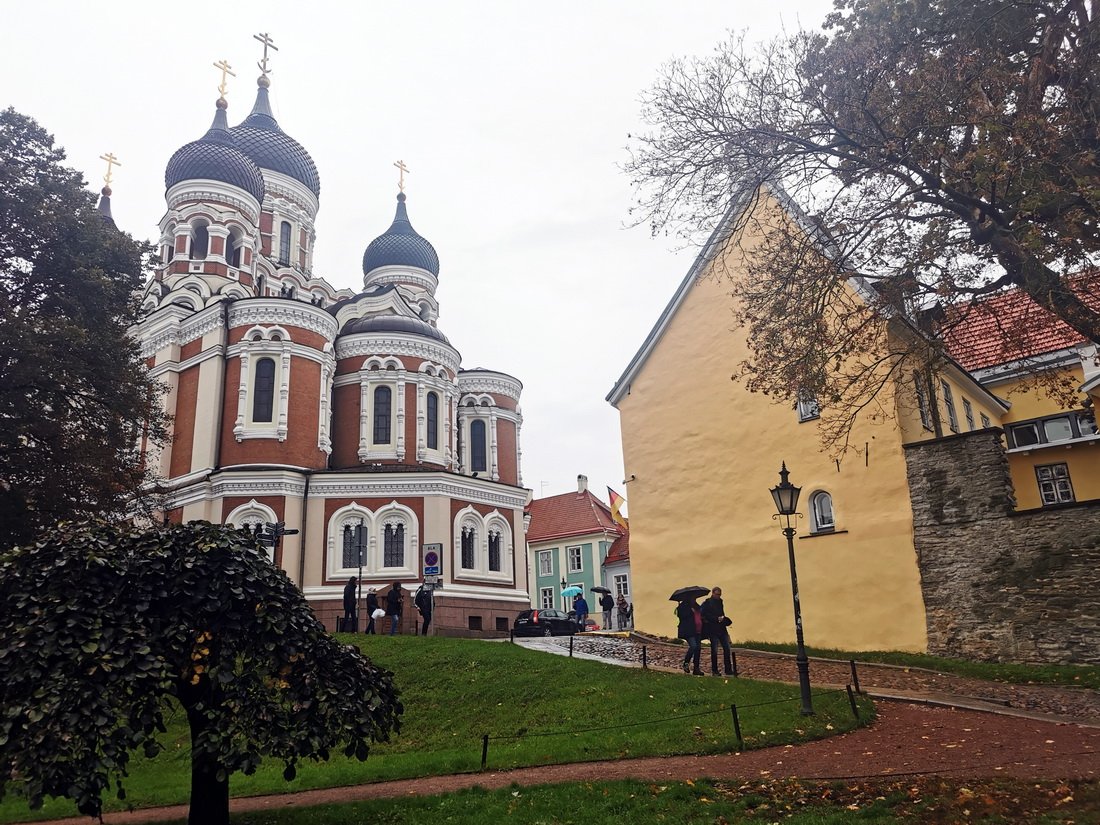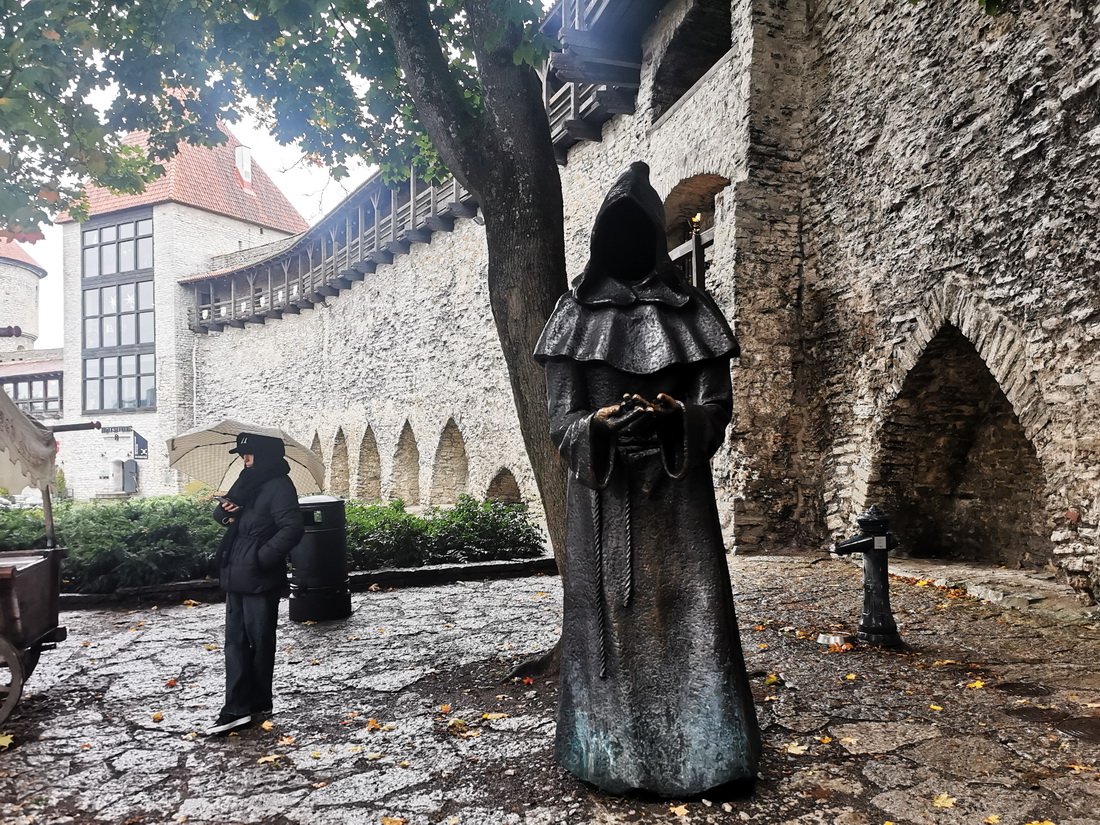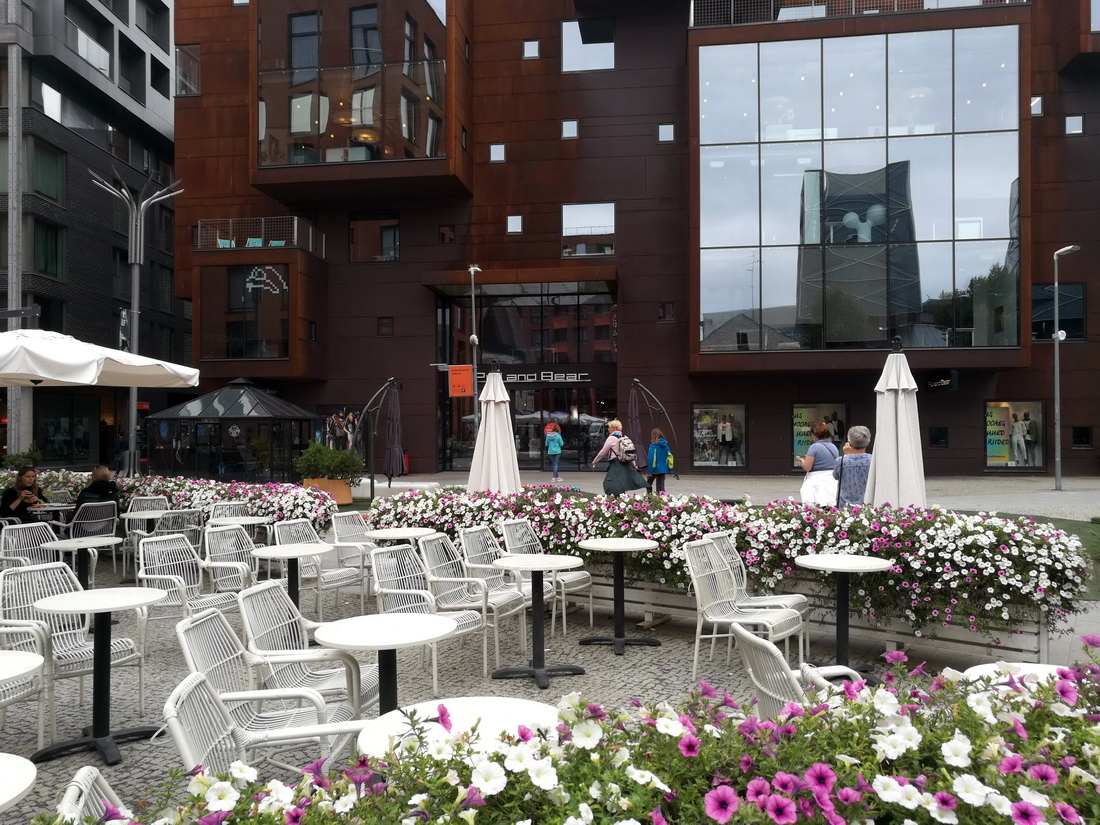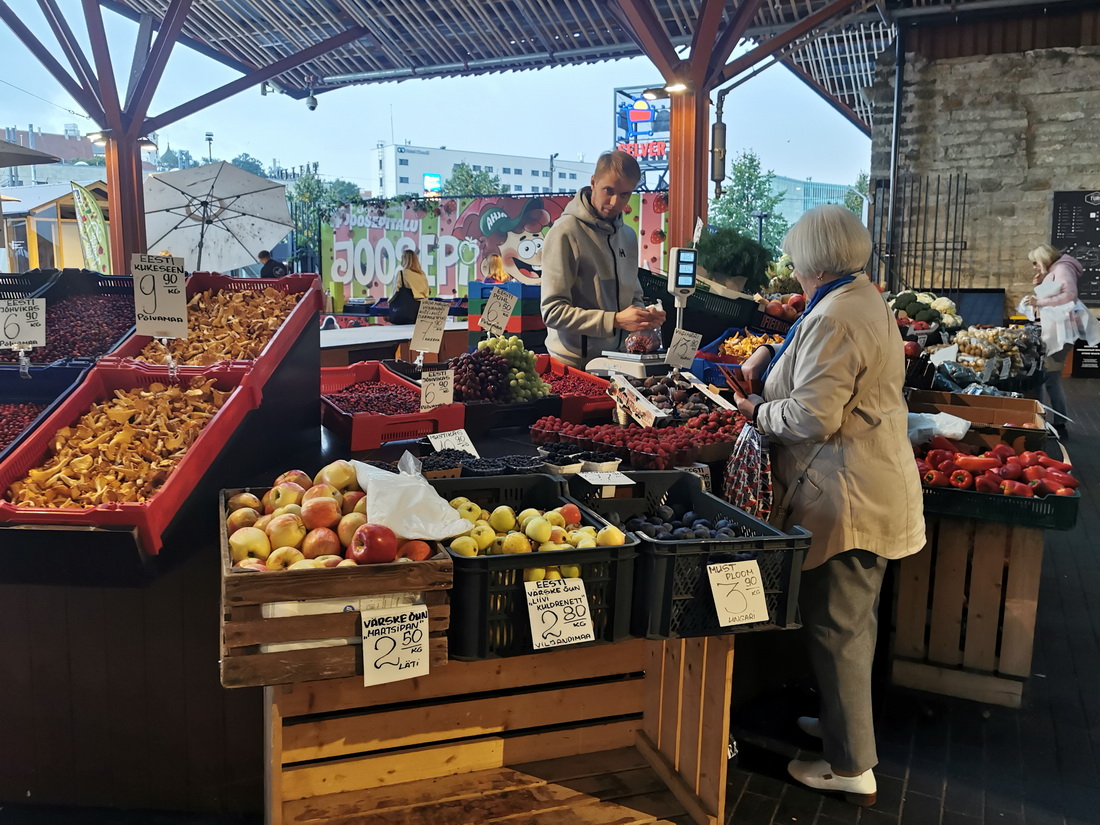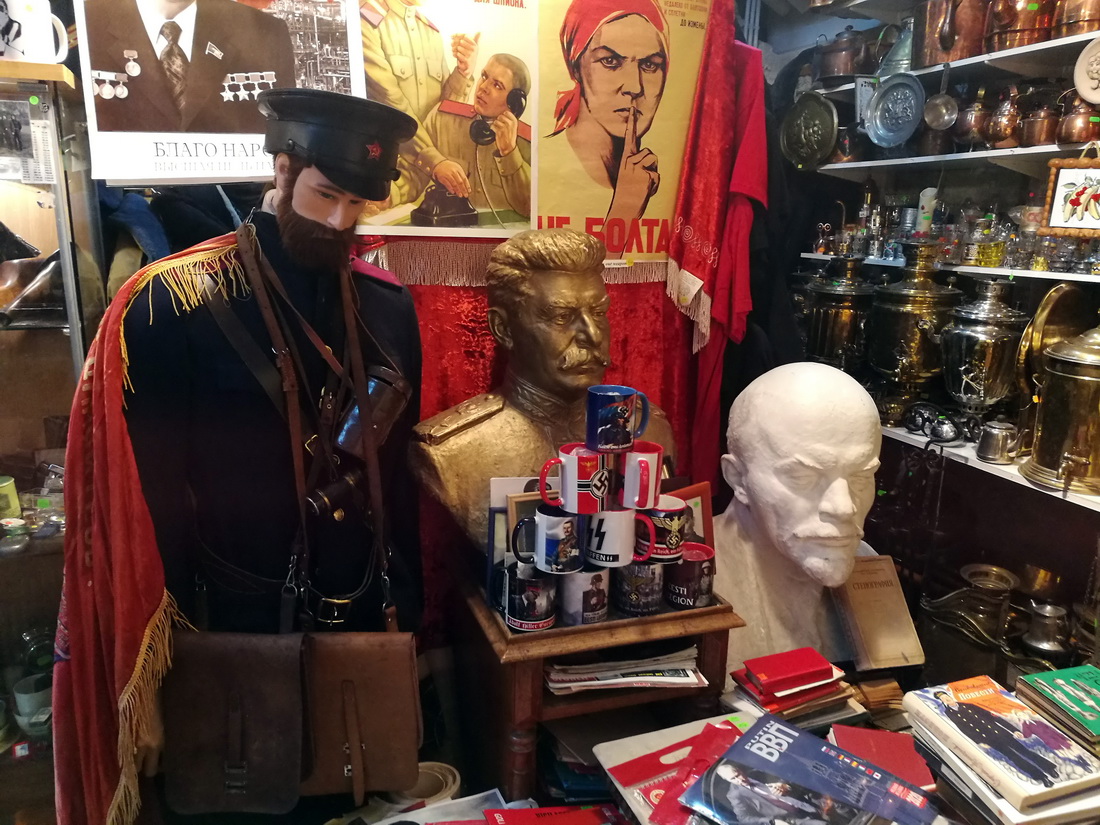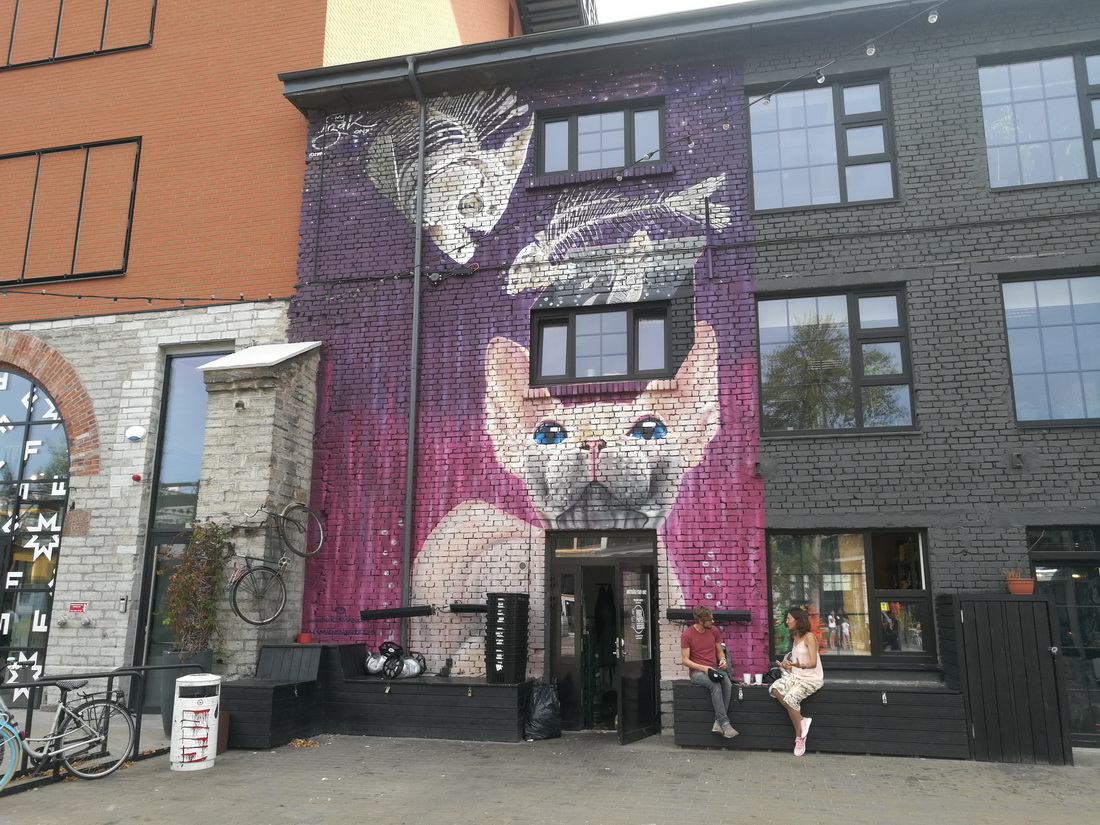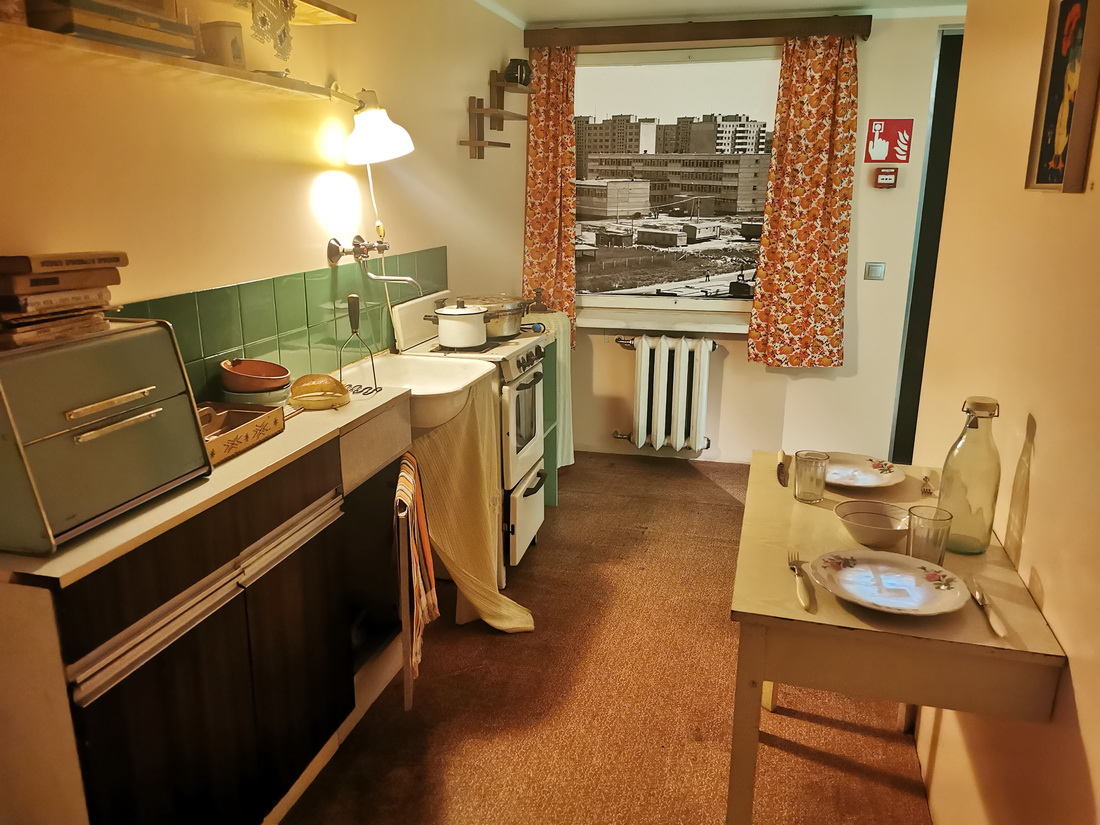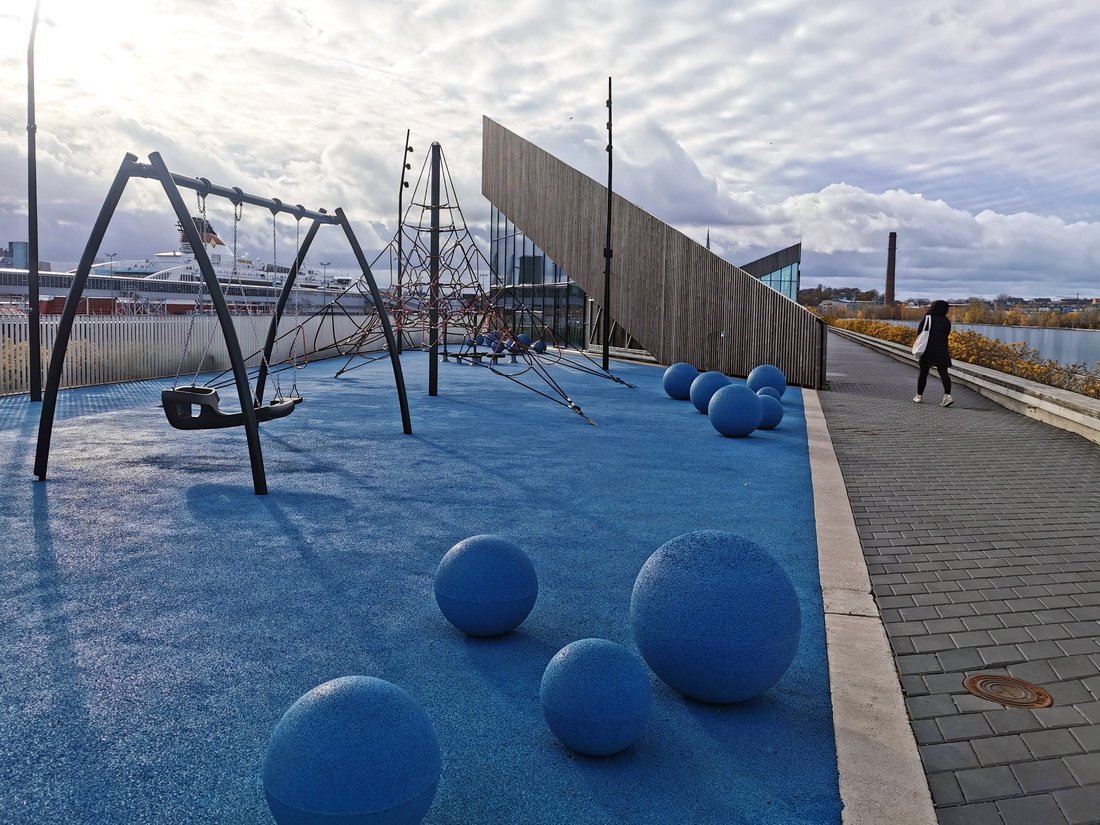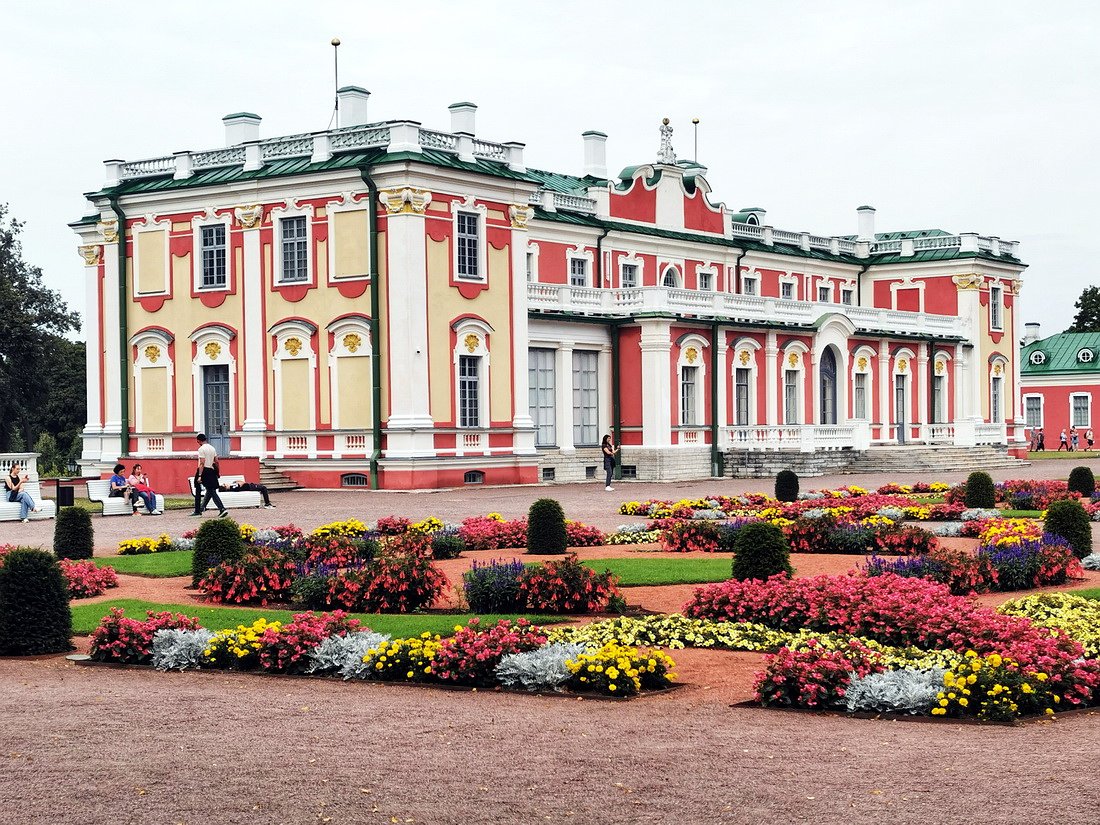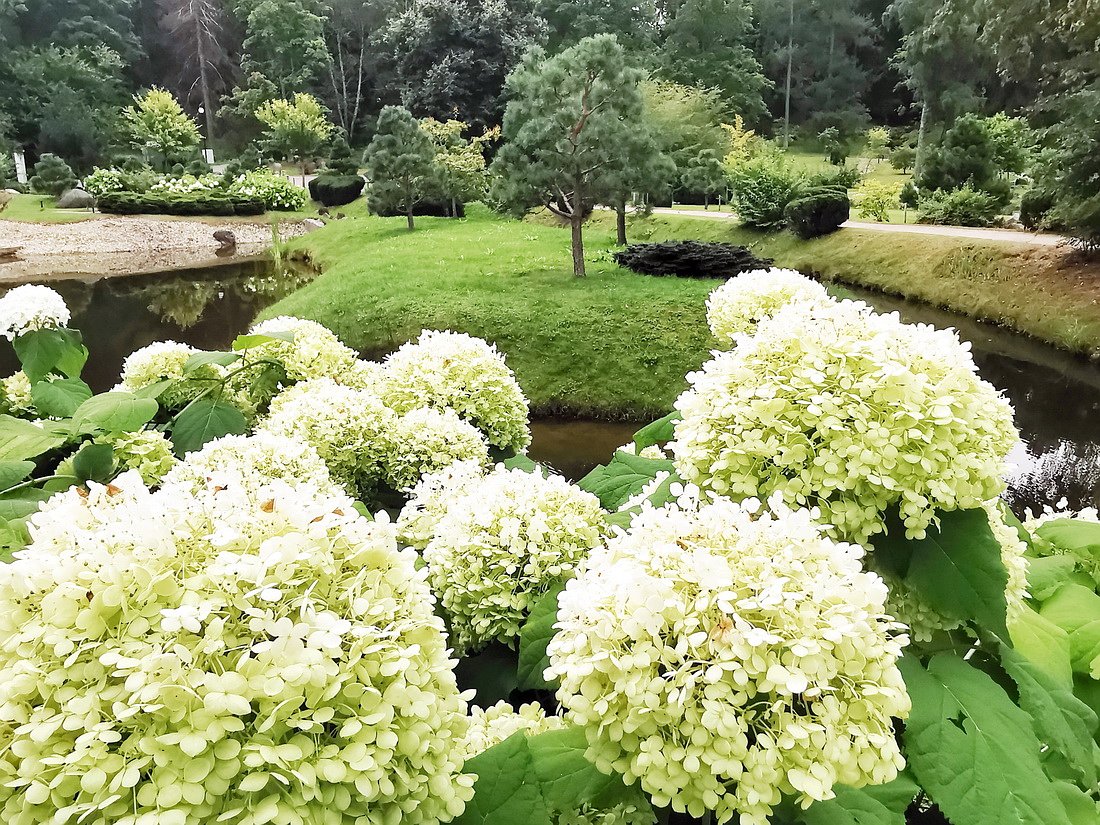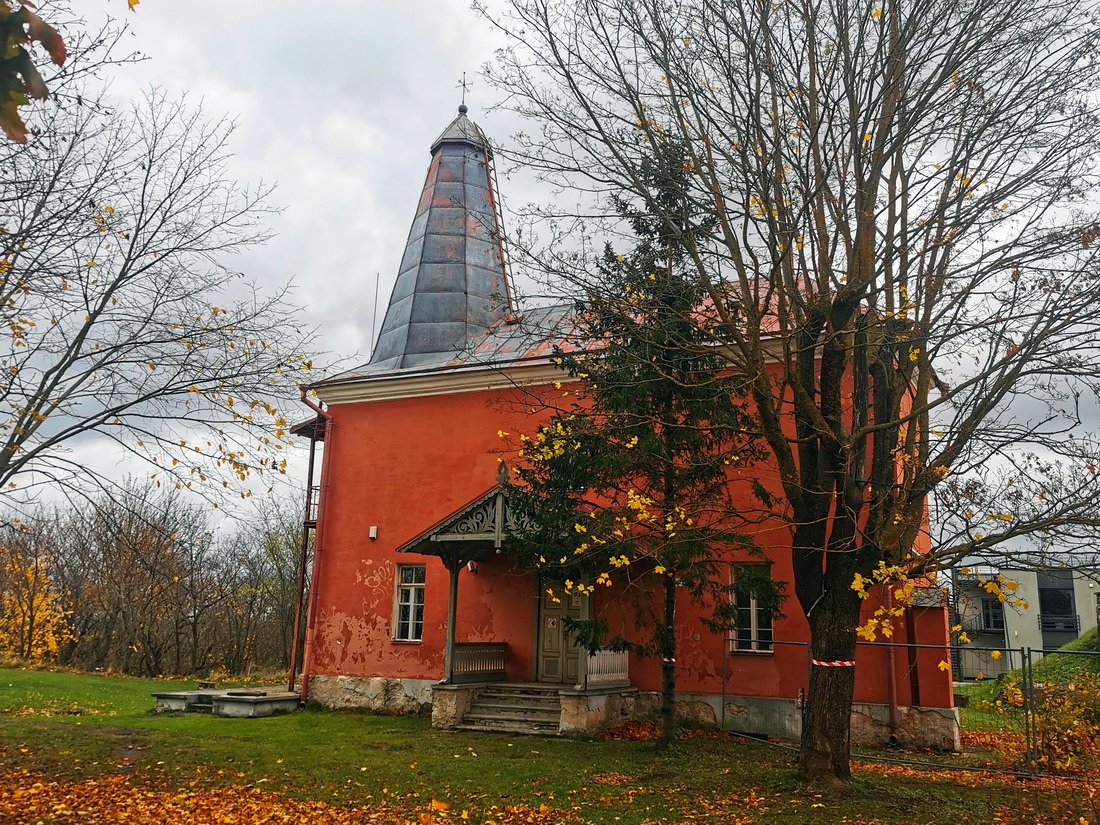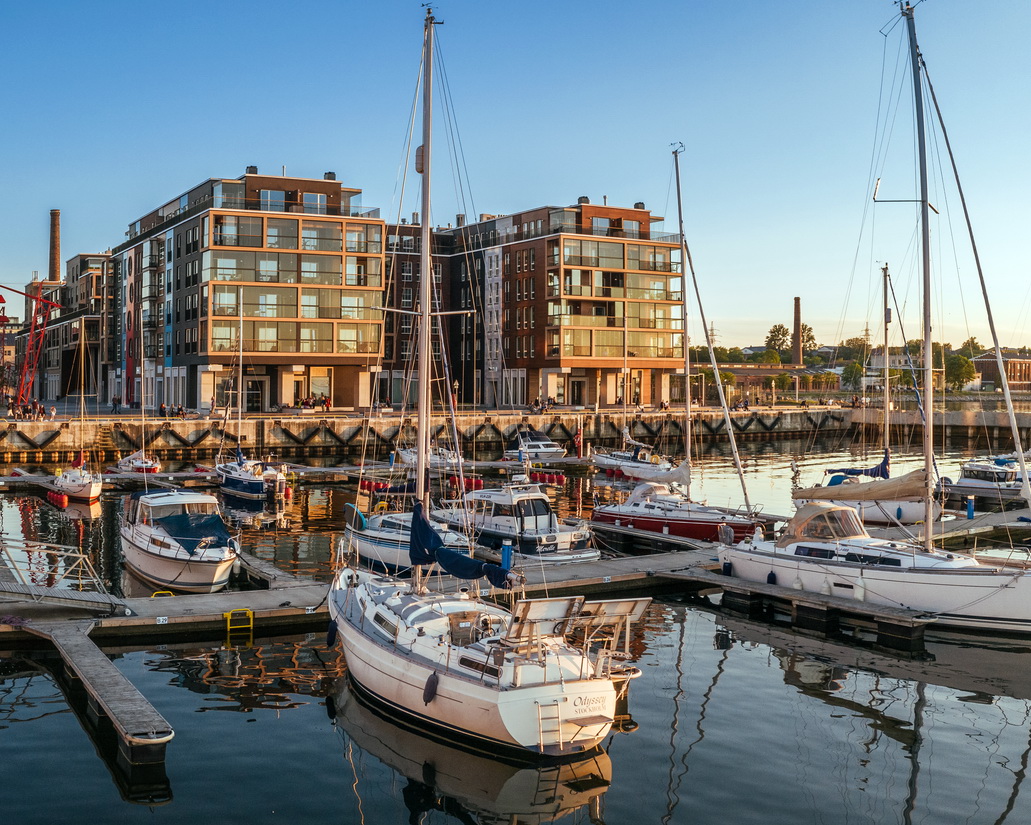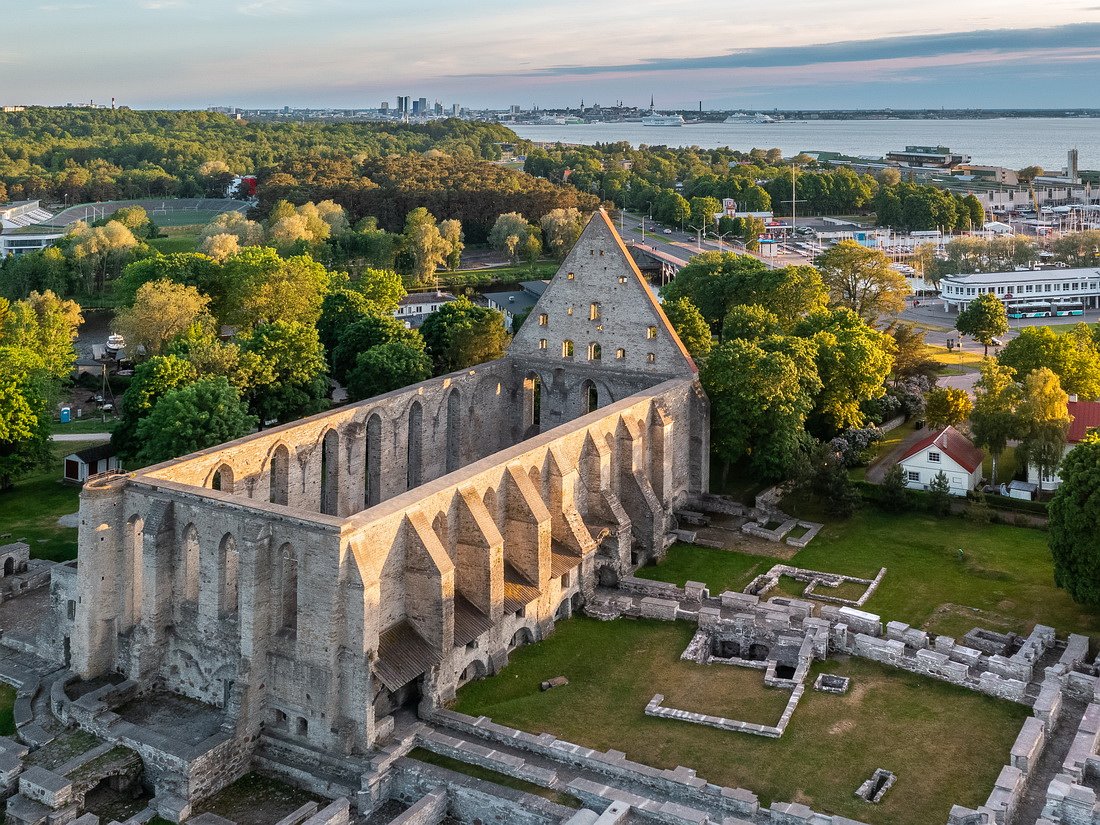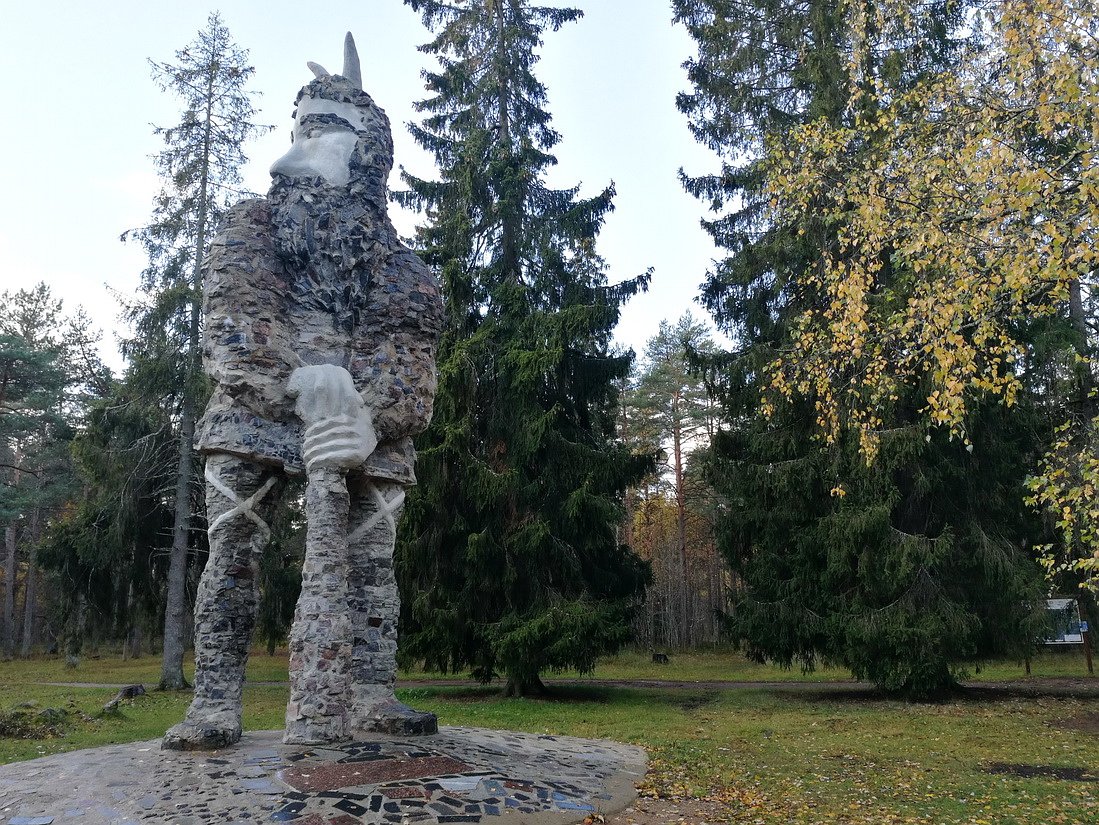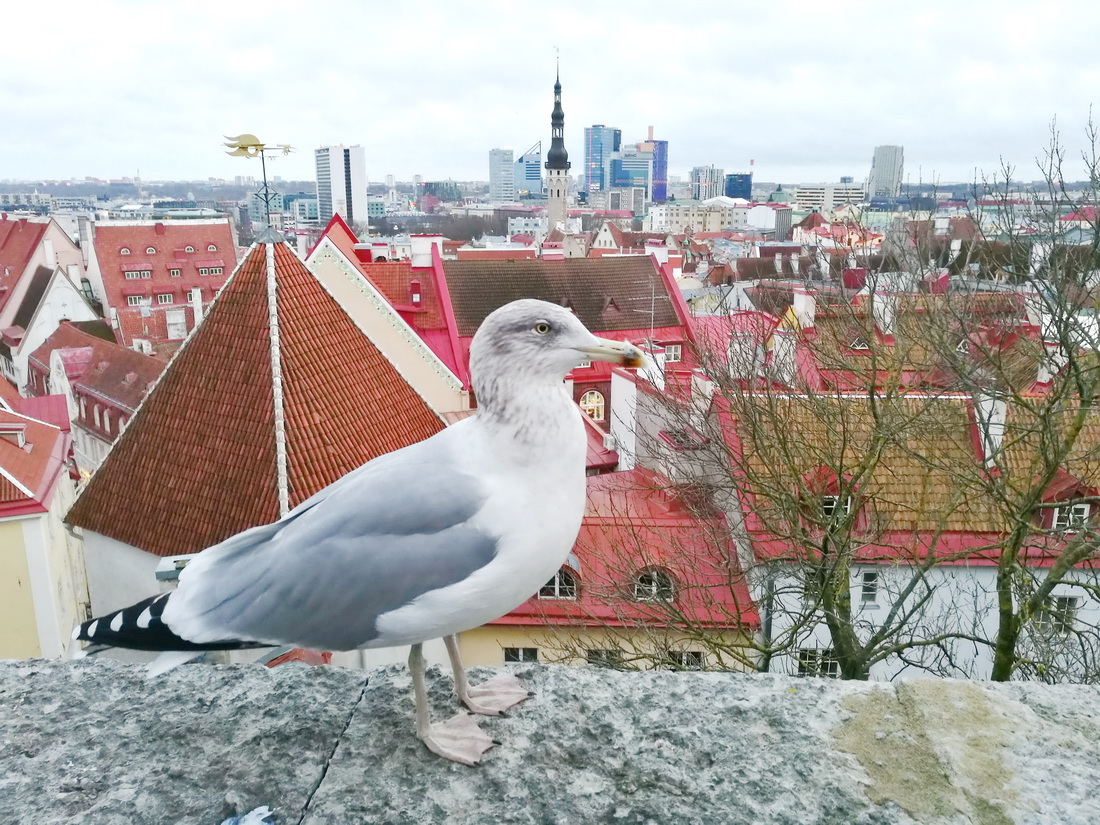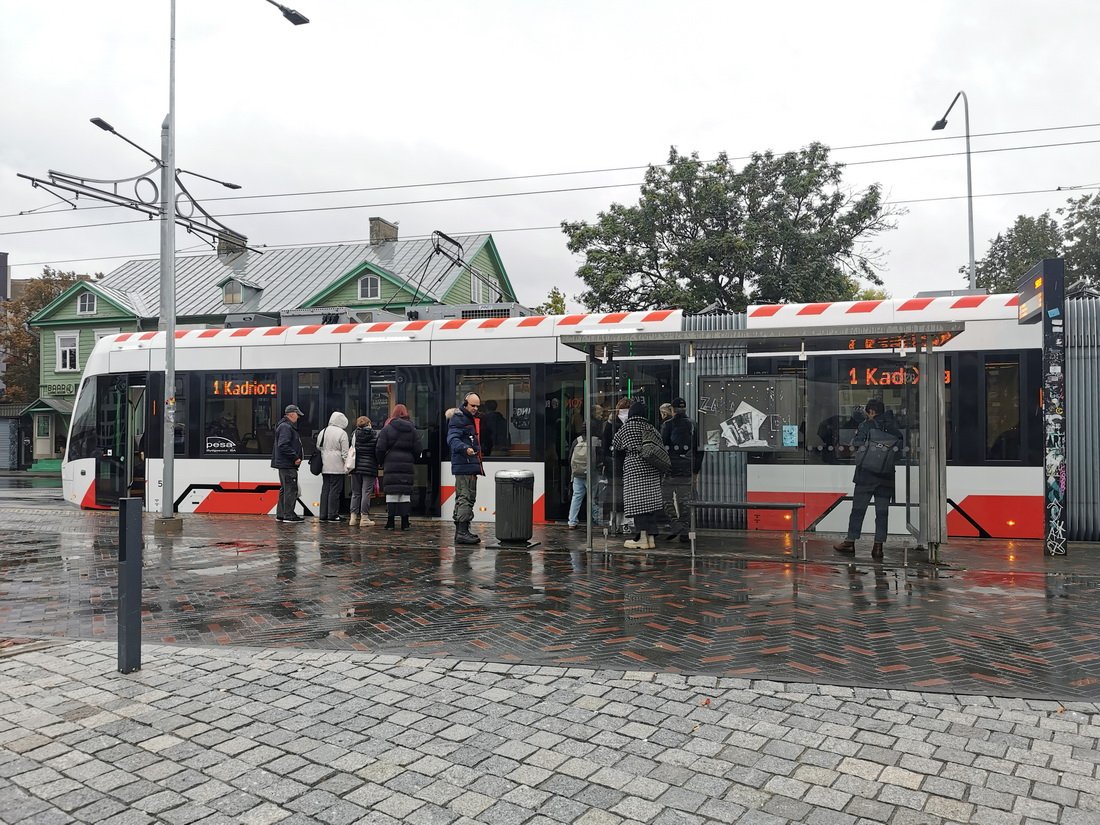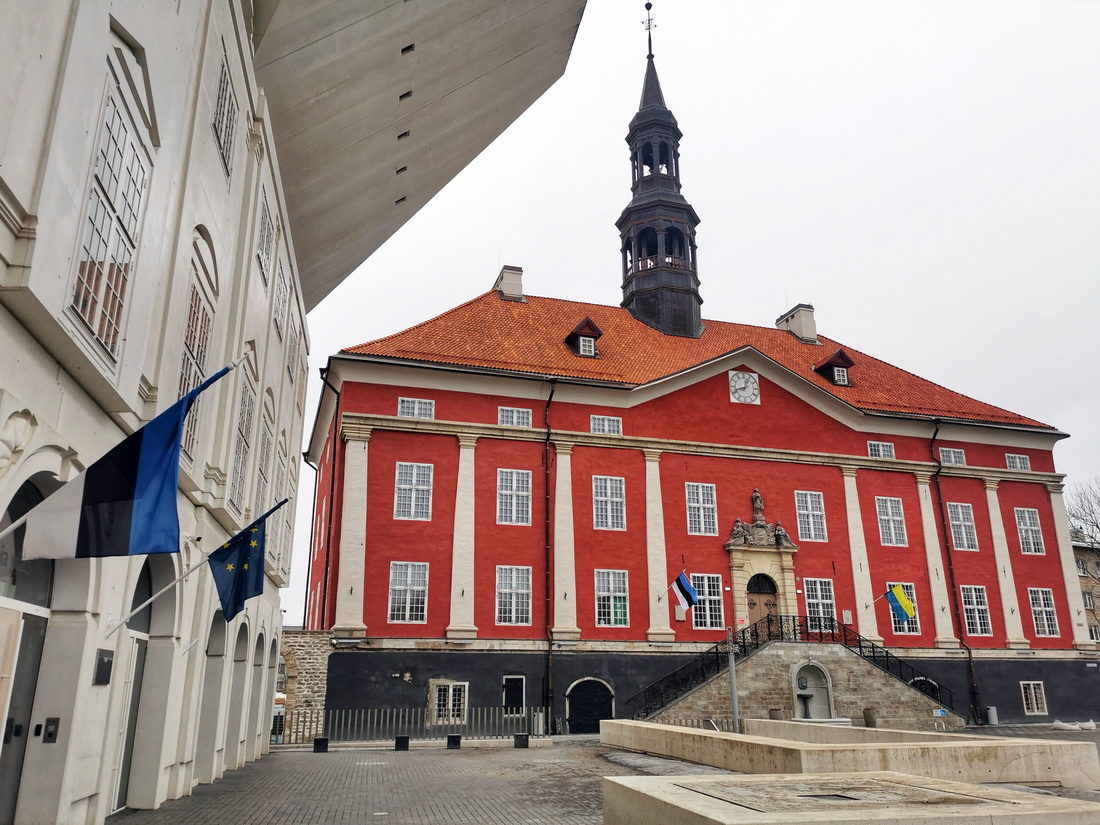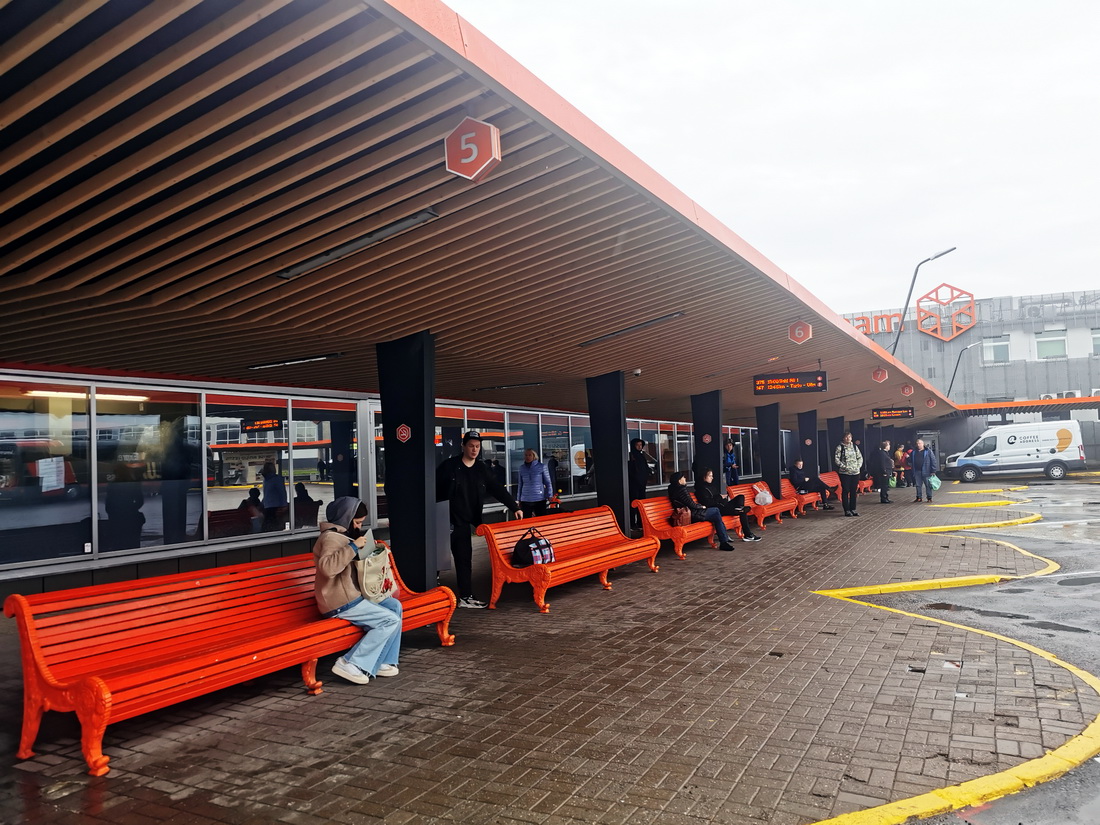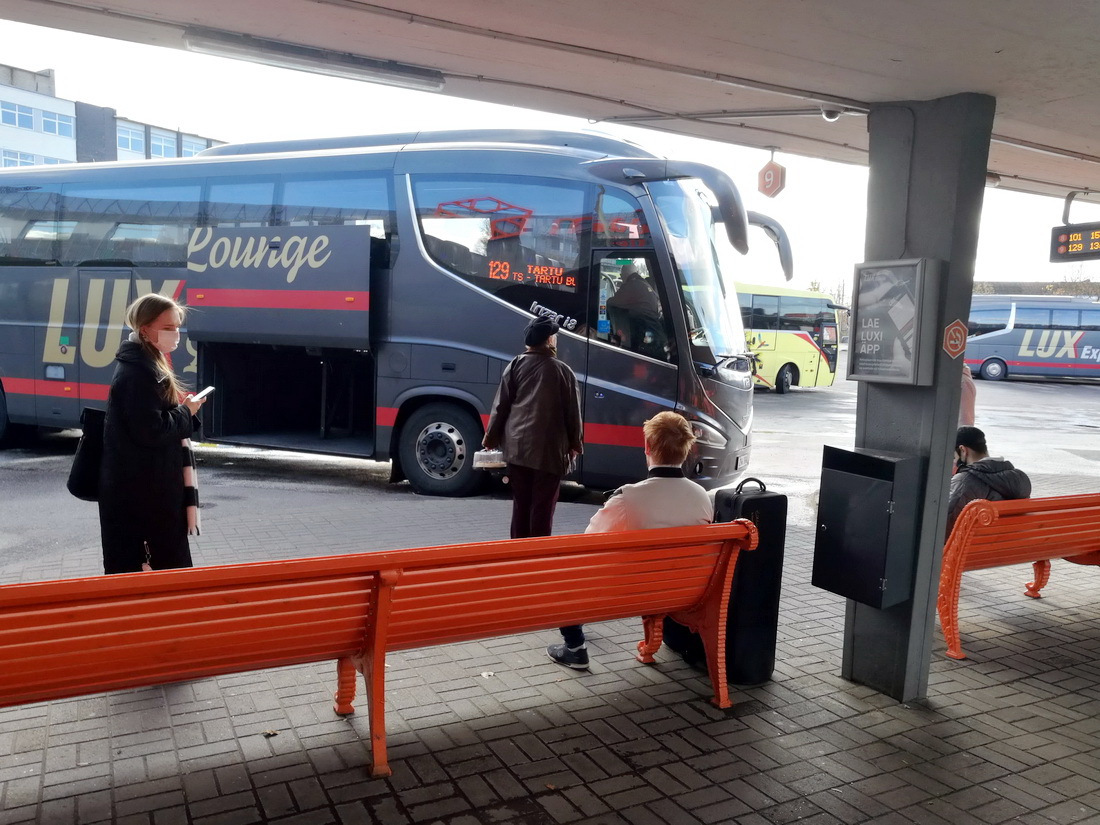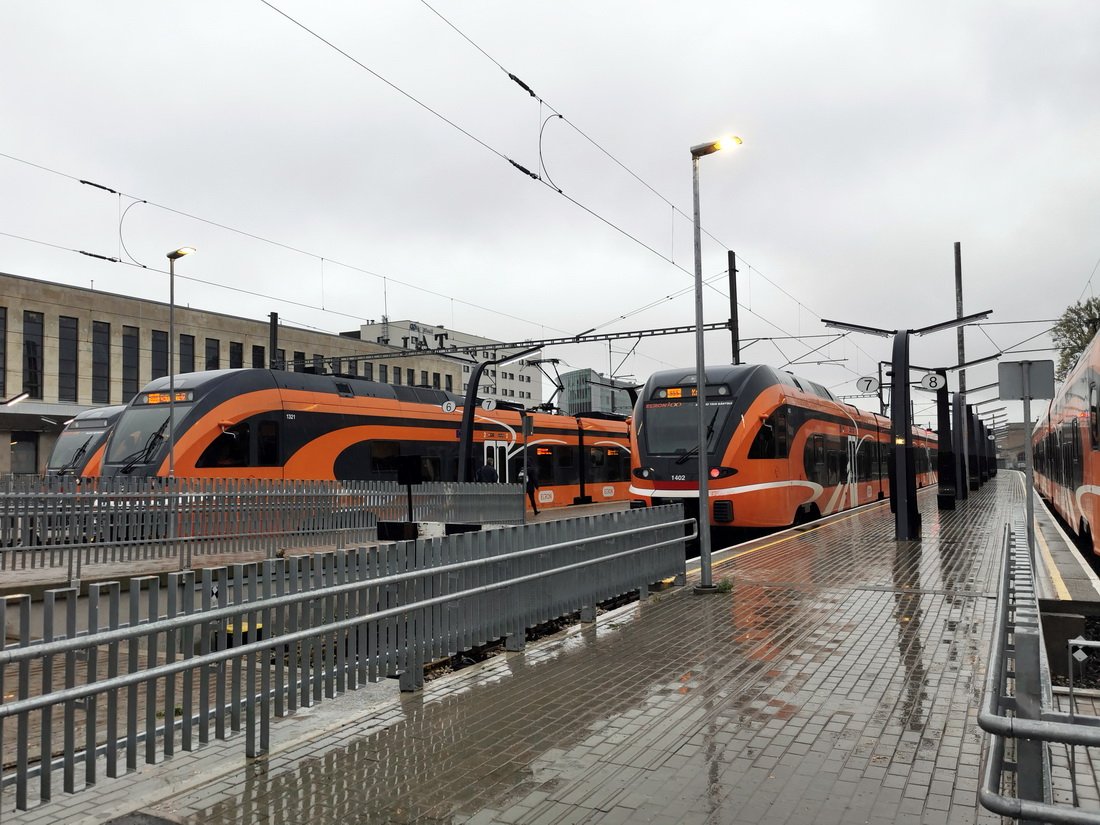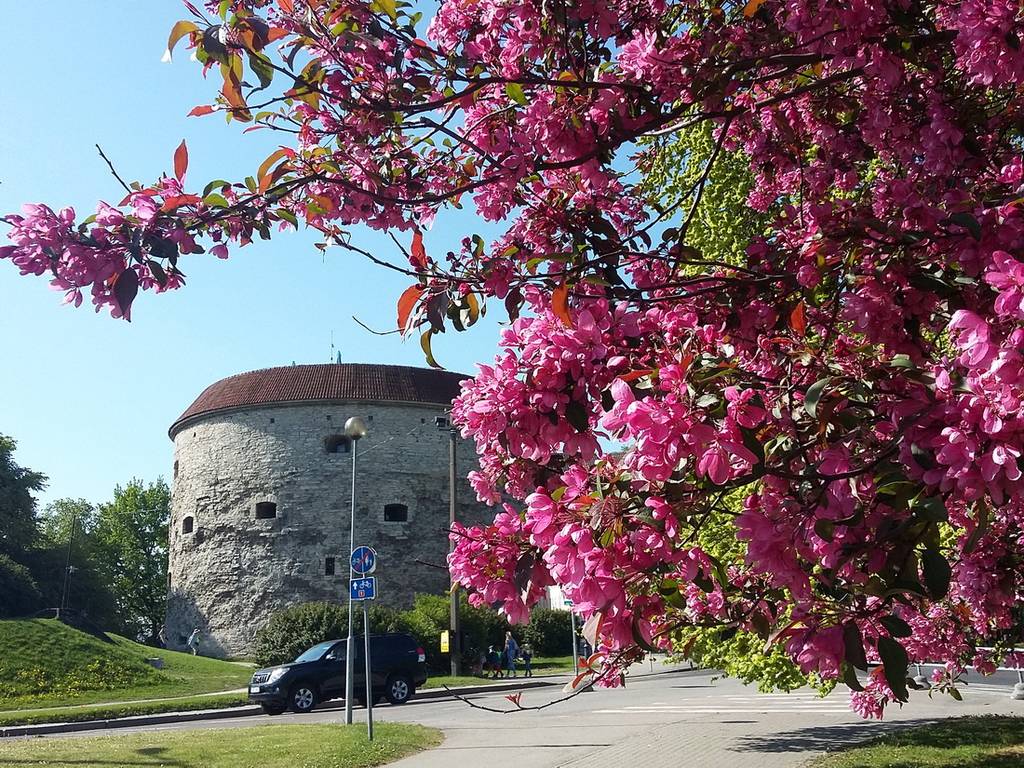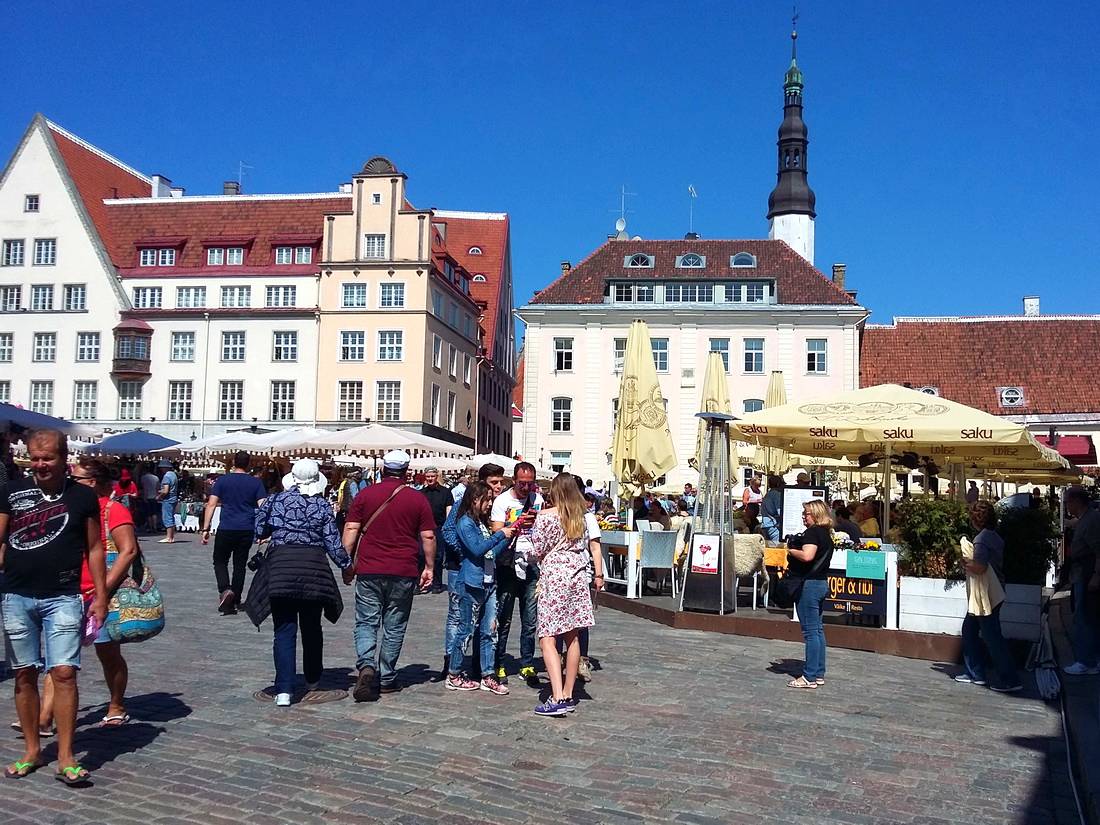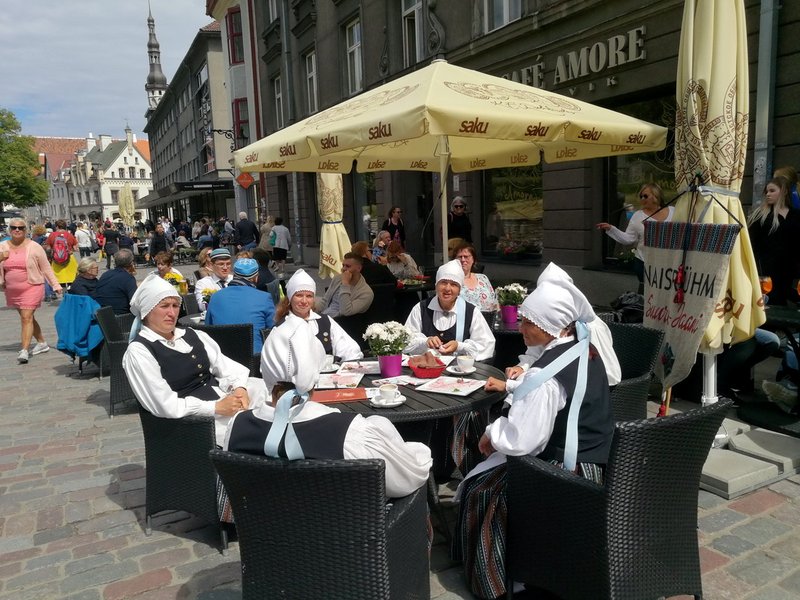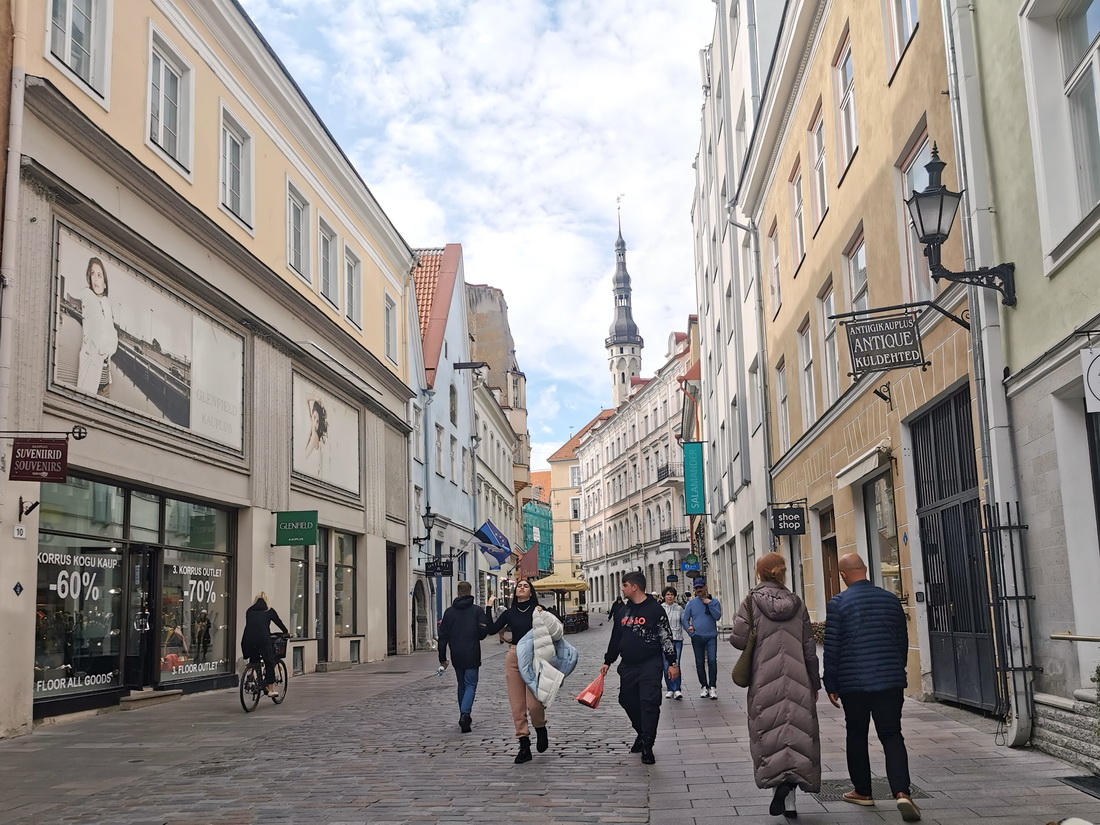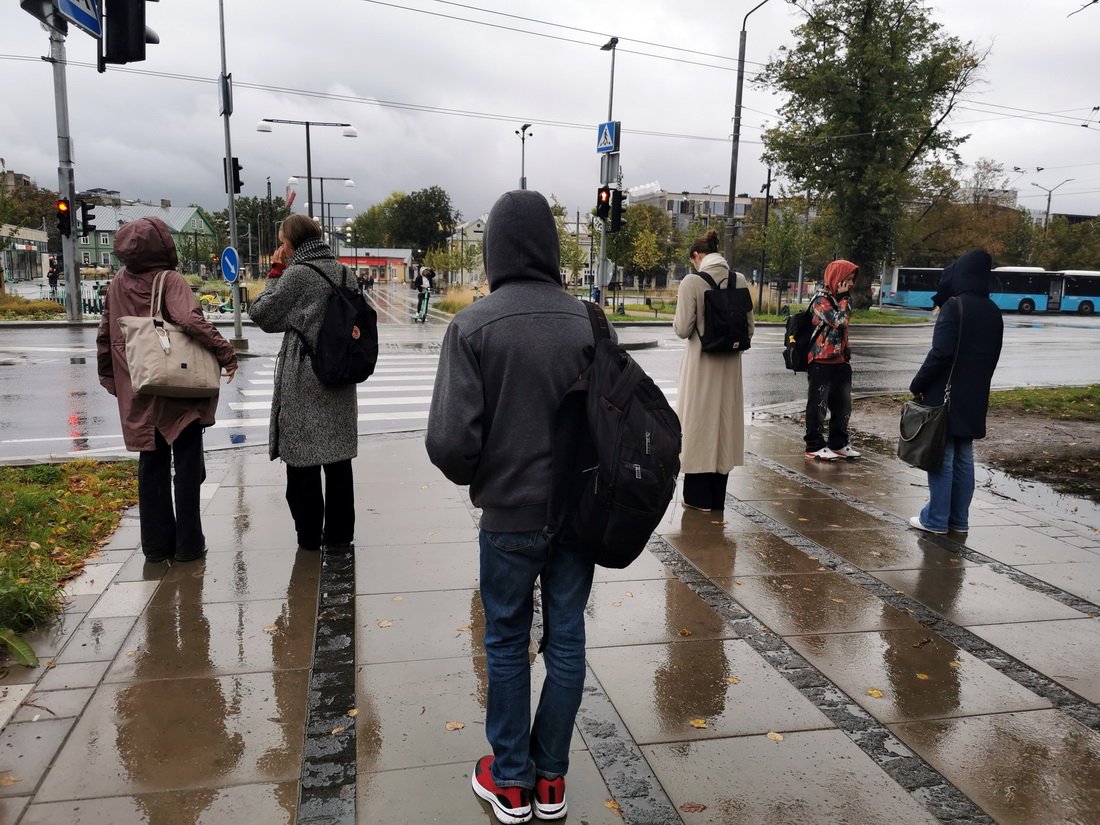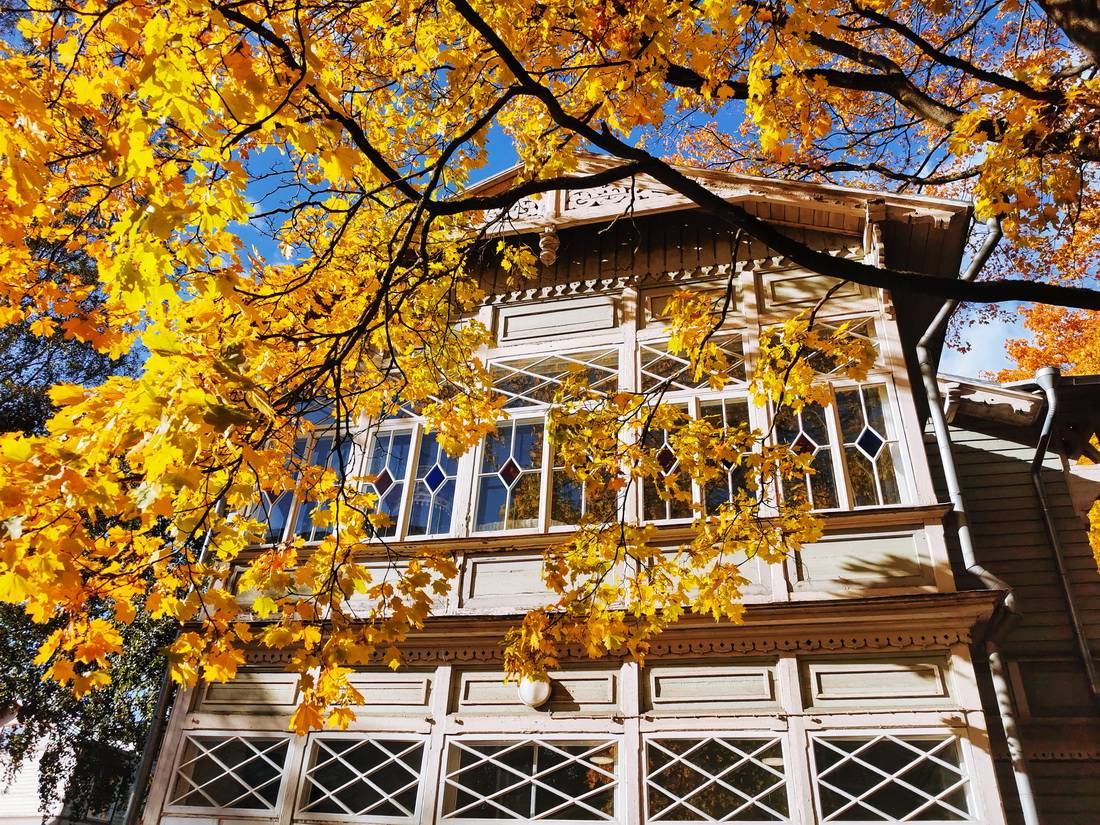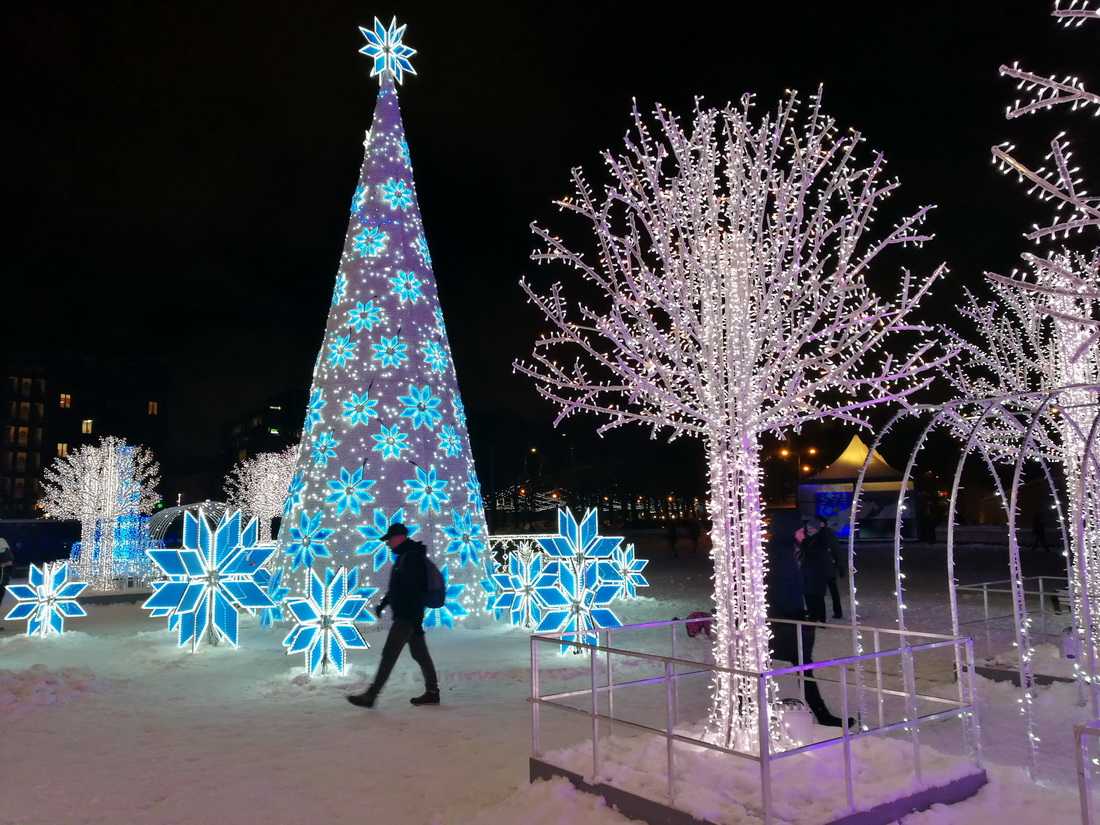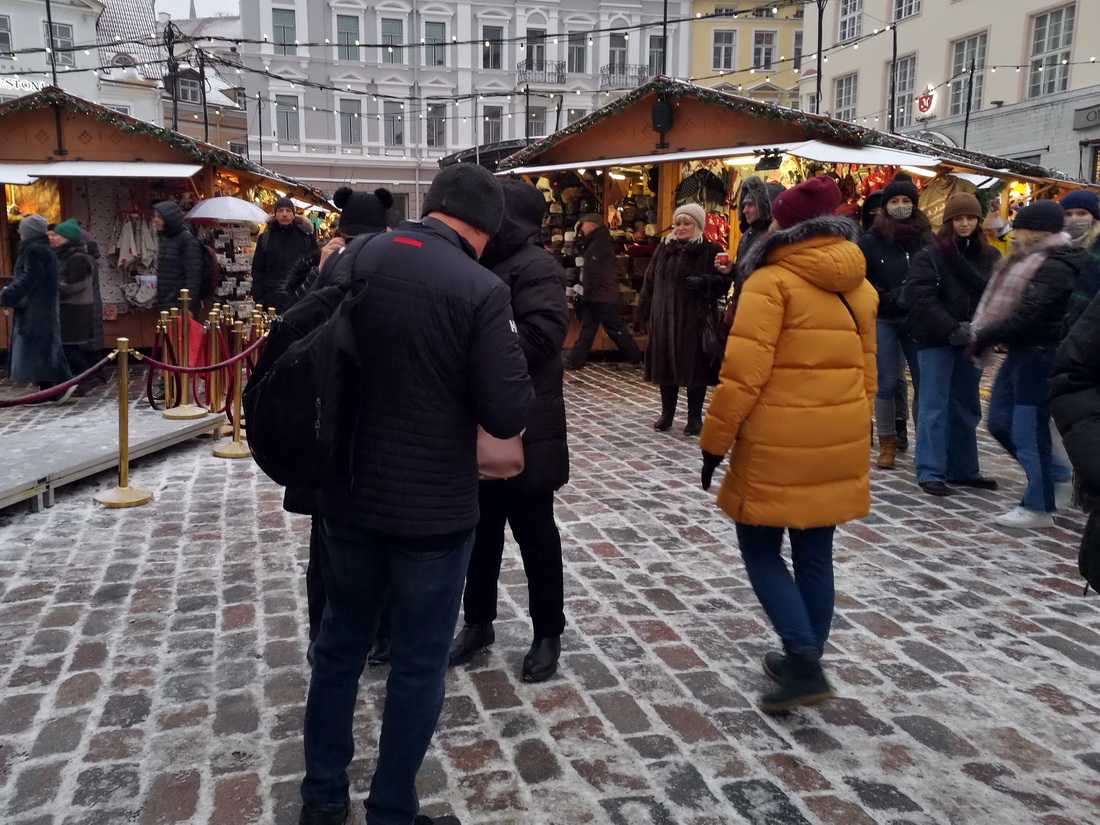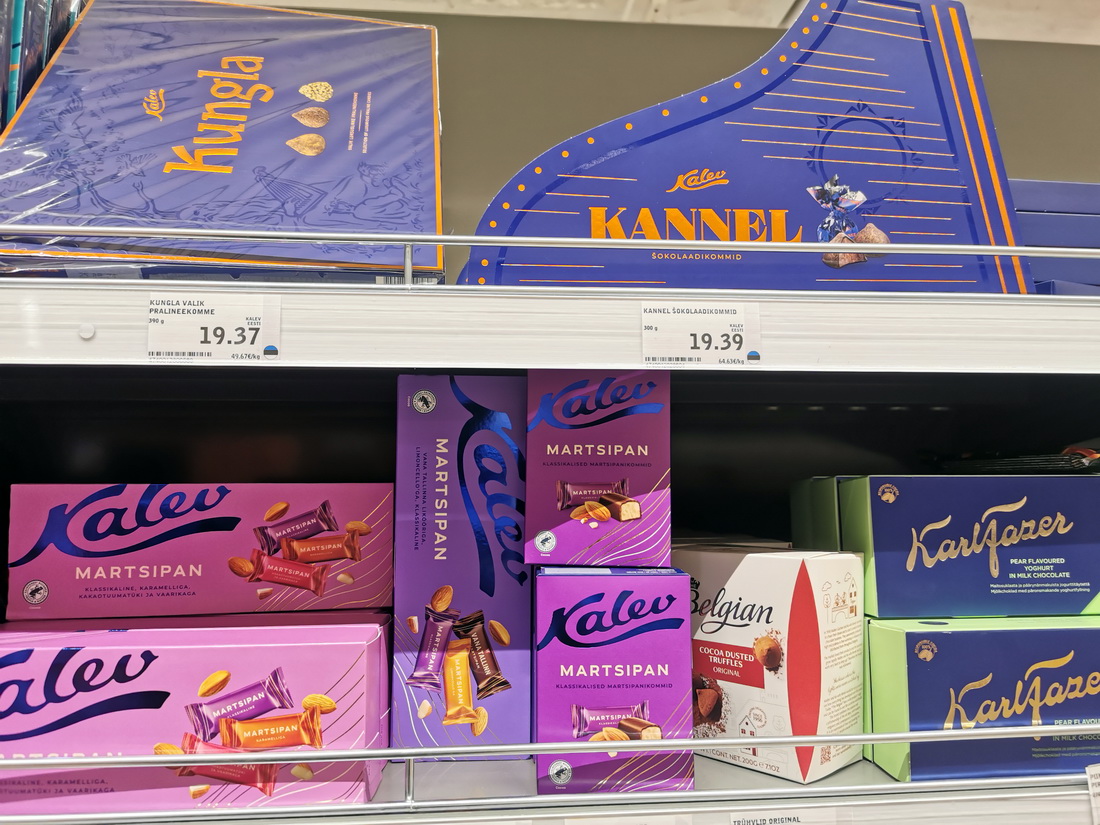Whether you’re here for a long weekend or just hopping over from Helsinki, this guide will walk you through the best things to do in Tallinn — plus where to stay, how to get around, what it costs, and a few tips only locals tend to know.
I’ve organized everything from central must-sees to offbeat day trips, with seasonal advice and links to more detailed posts along the way.
Old Stones, New Ideas
Tallinn is a small capital with a big personality — bold, creative, and full of contrast. Centuries-old charm blends into daring ideas: cobbled alleys meet street art, medieval towers sit next to tech startups, and oregano and sedge sprout from the central square like it’s the most natural thing in the world.
It’s a city that doesn’t just show off its past — it experiments with it. A cruise terminal powered by the sea. Delivery robots trundling down the street. A Soviet nightgown exhibition in one gallery, deep-cut British street art in the next.
Tallinn isn’t just pretty — it’s practical. Easy to get around. Easy to fall for. Just bring a jacket (the Baltic wind has opinions) and a good sense of humour.
My Top Picks and Surprises
Once upon a time, visitors came to Tallinn just to wander the medieval Old Town — a UNESCO World Heritage Site wrapped in cobblestones and legends. But the city has evolved. It’s bolder now, brighter, full of unexpected angles and stories you don’t see on postcards.
In this Tallinn travel guide, I’ve mapped out my favourite places — from towering spires and cosy squares to coastal lighthouses lighthouses, surrealist giraffes, and cold war tunnels. Everything’s arranged by distance from the centre, starting right in the heart of the Old Town and spiralling outward, one curious stop at a time.
🗺️ Expect the essentials, the oddities, and a few quiet corners that locals tend to keep to themselves.
Heart of Tallinn
1. Town Hall & Square
Start your Tallinn trip at the heart of it all: Town Hall Square (Raekoja plats). In summer, it turns into an Estonian meadow — quite literally — with oregano, sedge, and wildflowers blooming between benches and café tables. Perfect for people-watching with a slice of kringel, sometimes with cinnamon.
In winter, the square becomes a glowing postcard. The city’s main Christmas tree takes centre stage, with wooden stalls, twinkling lights, and the soft swirl of snow. Yes, there’s a carousel. No, it’s only for children.
Right on the square stands the Town Hall (Raekoda) — over 600 years old and still the best-preserved Gothic town hall in Northern Europe. And just a few steps away: the famous Olde Hansa restaurant, where the staff wear wool and serve honey beer like it’s 1475.
And next door: the Town Hall Pharmacy (Raeapteek). Open since at least 1422, it’s part museum, part shop — and free to visit. For more marzipan (and less Latin), the Kalev Marzipan Museum Room is just 100 m away.
🎫 Entry to both the pharmacy and the marzipan museum room is free.
2. Oleviste Church
Climb the tallest spire in medieval Europe — and hang onto your hat. From the 16th to the 17th century, St. Olaf’s Church (Oleviste kirik) was believed to be the tallest building in the world. Whether that’s true or just a very persistent rumour, one thing is certain: the views from the top are unbeatable.
The climb is steep and narrow — 232 stone steps in a tight spiral — but the reward is an open-air platform with a full 360° panorama of Tallinn, the sea, and beyond. There are no glass walls here, only a wire fence and a strong breeze, so dress accordingly (and maybe skip the floppy hat).
The church is now home to a Baptist congregation. Inside: pale stone, simple benches, and soft echoes. But for most visitors, it’s the view from 124 metres up that steals the show.
🎫 Observation tower open April–October. Entry €5, cash or card accepted.
3. The Estonian Children’s Literature Centre
Tucked into a medieval townhouse near St. Olaf’s Church, the Estonian Children’s Literature Centre is a hidden gem for readers, illustrators, and anyone who grew up on woodland creatures with strong opinions.
Inside, you’ll find exhibitions dedicated to Estonian children’s books, including the beloved Pokuraamat by Edgar Valter — a quirky classic where shaggy forest spirits go about their mossy business. The centre also hosts regular illustrator exhibitions.
The small shop sells themed souvenirs — books, prints, and postcards that match the magical tone of the place. It’s a calm, creative stop — even if you’re not travelling with kids.
🎫 Entry is free. Closed on Sundays and Mondays. Here’s how to find it →
4. Niguliste Church
From the outside, Niguliste looks like a classic Gothic church. Step inside, though, and you’re in for something unexpected: part medieval chapel, part art museum, part panoramic viewpoint — with a glass elevator, no less.
The star of the collection is Dance of Death — a 15th-century painting where skeletons gleefully dance with merchants, monks, and nobles. It’s grim, detailed, and strangely hypnotic. You’ll also find altarpieces, coats of arms, and centuries of sacred art displayed with quiet elegance.
At the top of the tower, a modern viewing platform offers some of the best rooftop views in Tallinn — fully enclosed in glass, with no wind or wire fences.
🎫 Museum and tower open year-round. Entry €12 (includes museum + lift to the viewpoint). Free with Tallinn Card.
5. Navitrolla Gallery
Just across from Niguliste Church, at the quiet start of Lühike jalg street, hides a whimsical little stop — the gallery of Estonia’s quirkiest surrealist, Navitrolla.
Inside, giraffes float through pastel skies, mushrooms grow taller than houses, and sheep seem to be questioning the meaning of life. It’s strange. It’s delightful. And somehow, it makes perfect sense in Tallinn.
Some of his works decorate Tallink ferries, but here you can get closer — browse postcards, prints, and originals. The space is free to enter, rarely crowded, and filled with quiet oddball charm.
🎫 Free entry. Opening hours may vary — check the official site here →
6. Maritime Museum
Fat Margaret may sound like a pub — but it’s actually a thick-walled cannon tower guarding the edge of the Old Town. Inside: one of the best maritime museums in the Baltics, packed with stories of sailors, smugglers, storms, and sea maps.
Expect model ships, old navigation tools, sailors’ uniforms, and even a bathyscaphe (essentially a very claustrophobic mini-submarine). Kids love the interactive displays; adults get drawn into the mix of legends and real history.
This is just one part of Tallinn’s maritime story. The other is the Seaplane Harbour (Lennusadam) — home to the big stuff: ships, a real submarine, and an enormous seaplane hangar. You’ll find that one further out, and yes, it gets its own spotlight later in the guide.
🎫 Open daily. Entry €15 for adults.
7. Museum of Photography
A few steps behind the Town Hall, on Raekoja Street, sits a small museum that many visitors miss — and shouldn’t. Housed in a 15th-century former prison, the Museum of Photography offers a quiet, powerful look at how Tallinn once saw itself.
The exhibits cover early Estonian photography, with portraits dating back to the 1840s — shopkeepers in stiff collars, children in wool coats, streets before tourism. You’ll also see antique cameras, developing equipment, and moody black-and-white cityscapes that make time feel bendable.
It’s small, creaky, and full of quiet charm — like the photos it holds.
🎫 Open Tuesday to Sunday. Entry €6.
8. KGB Prison Cells
From the outside, it looks like just another grand building in Tallinn’s Old Town. But in the 1940s and 50s, Pagari 1 was the city’s most feared address — the KGB headquarters, where political prisoners were interrogated, held in isolation, and tortured.
The museum doesn’t dramatise what happened here. It doesn’t need to. The empty cells speak for themselves — bare walls, cold floors, and a punishment cell no larger than a cupboard. There’s also a small exhibition about Soviet surveillance, deportations, and life under occupation.
If you’re curious about Estonia’s 20th-century history, this is one of the most haunting, human stops in the city.
🎫 Open Wednesday to Sunday. Entry €8.
9. Tall Hermann Tower
Tall Hermann (Pikk Hermann) is more than just a tower — it’s a national symbol. Every morning, the Estonian flag is raised here at sunrise.
Built in the 14th century, the tower rises from the corner of Toompea Castle and has seen empires and occupations come and go.
You can’t usually go inside, but on special dates like Flag Day (Eesti lipu päev, 4 June), the doors open for public visits. Inside: steep stairs, narrow corridors, and just one direction — up.
🎫 Entry only on selected dates. Free, but timed — arrive early if you want a spot.
10. The Dome Church
The oldest church in mainland Estonia, St. Mary’s Cathedral (or Toomkirik), has stood on Toompea Hill since the 13th century. From the outside, it’s modest — white walls, a dark spire, and no grand façade. But step inside, and the walls come to life.
Over a hundred noble family coats of arms decorate the interior — silent reminders of the Baltic-German legacy that shaped Tallinn for centuries. The space feels calm, bright, and untouched by the tourist rush just a few streets away.
Climb the 143 narrow steps to reach the bell tower for one of the best city views — quiet, high, and full of red rooftops.
🎫 Entry €5 for adults (including tower). Open daily in summer, limited hours in winter.
11. Alexander Nevsky Cathedral
With its black onion domes and golden crosses, the Alexander Nevsky Cathedral is hard to miss. Built in 1900 during the Russian Empire, it still dominates Toompea Hill — and still sparks debate.
The architecture is Russian Revival, ornate and imposing. Inside, it’s dim and glowing: flickering candles, gilded icons, the scent of wax and incense. You might hear quiet chanting if a service is underway.
It’s free to enter, but this is an active Orthodox church — not a museum. Photos aren’t allowed, and modest dress is expected: shoulders and legs covered, headscarves for women, no shorts for men.
🎫 Entry free. Open daily.
12. Danish King’s Garden
This shady courtyard just below the Alexander Nevsky Cathedral is one of those spots that feel half real, half legend. Ivy on the walls, red roofs below — and three hooded iron monks who look like they’ve been waiting here since the 1200s (and aren’t in a hurry to leave).
According to the story, this is where the Dannebrog — Denmark’s red-and-white flag — fell from the sky during a battle in 1219. People still celebrate the moment here every 15 June with speeches, music, and lots of flags.
It’s a good place for a breather between climbs. Quiet in the mornings, dramatic in the afternoons — and reliably full of people trying to out-stare the monks.
🎫 Entry free. Open at all hours.
13. Kiek in de Kök Museum
Despite the name, Kiek in de Kök isn’t a place for cake — it’s a 15th-century cannon tower where guards once claimed they could spy into people’s kitchens from the top. The view’s still great, but now it’s all about Tallinn’s defences: weapons, armour, models, and stories of how the city kept intruders out.
But the real surprise? It’s underground.
The Bastion Tunnels, built in the 1600s, run beneath the city walls — part medieval bunker, part Cold War survival zone. One minute you’re dodging cannonballs, the next you’re looking at Soviet-era gas masks and flickering lightbulbs. Chilly, eerie, and unforgettable.
🎫 Entry €14 (includes both museum and tunnels). Open Tuesday to Sunday. Bring a jacket — the tunnels are cold even in summer.
14. Rotermanni Quarter
Just a short walk from the Old Town, Rotermanni feels like someone hit fast-forward on Tallinn. Old industrial buildings now wear glass, timber, and bold angles — a kind of Nordic Lego city with bakeries.
It’s the kind of place where you come for a coffee and end up staying an hour. Or two. There’s good food, local design shops, a fancy Kalev chocolate store, and enough clean lines to make an architect tear up.
It’s not huge — you can cross it in 10 minutes — but it’s one of those neighbourhoods that makes Tallinn feel like it’s inventing itself as it goes.
🎫 No tickets needed, just wander in. Best enjoyed early evening when the café terraces come alive.
Near the Old Town
15. Balti Jaama Turg
Part market, part time machine, Balti Jaama Turg is Tallinn’s most lovable chaos. Just behind the train station and five minutes from the Old Town, it brings together fresh food, street snacks, antiques, and the occasional Soviet oddity.
Downstairs: berries, mushrooms, smoked fish, dumplings, crepes, caviar — and plenty of quick lunch options. Office workers from nearby studios and shops pop in for a bite between meetings.
Upstairs: vintage glassware, military medals, tinsel-covered Christmas memories, and every kind of indoor shoe your grandmother could dream of. It’s like rummaging through several Estonian grandmothers’ attics at once — in the best way.
Give yourself time. You’ll probably leave with both a snack and something you didn’t plan to buy.
🎫 Free to enter. Open daily. Go hungry.
16. Telliskivi Creative City
Once a cluster of old industrial buildings, now a colourful maze of cafés, studios, vintage shops, and street art. Telliskivi Creative City is where Tallinn lets its hair down — or shaves it off and dyes it pink.
Murals cover entire buildings. One café is inside a train carriage, another spills into a courtyard with mismatched chairs and dogs napping under tables. There’s always something on: pop-up galleries, design fairs, poetry slams, or just a DJ doing their thing at 2 in the afternoon.
It’s the kind of place where no one cares how you’re dressed — just grab a coffee and soak it all in.
🎫 Free to wander. Best during lunch or golden hour, when everything hums.
17. Vabamu Museum of Occupations and Freedom
This museum doesn’t try to impress with quantity — it stays focused, thoughtful, and quietly powerful. Vabamu tells the story of Estonia’s 20th century through personal voices: diaries, letters, interviews, and the everyday objects that people held onto through occupation, deportation, and return.
You’ll see a few Soviet relics — a kitchen, a prison door, a soda vending machine — but it’s the stories that stay with you. One room plays phone calls from survivors. Another invites you to stand under a glowing map of exile routes.
It’s a very specific kind of museum — more about listening than looking. If you’re not in the mood for heavy history, you might find it hard-going — but if you’re in the mood, it’s deeply moving.
🎫 Entry €11. Open daily. Give yourself at least an hour — more if you like to take your time.
The Furthest Stops
18. Cruise Harbour
You don’t need a cruise ticket to enjoy Tallinn’s Cruise Harbour — the terminal doubles as a public space, with some clever eco-tech built in. Solar panels on the roof, sea-sourced heating below, and a long wooden promenade curving overhead like a boardwalk in the sky.
It’s 850 metres of open-air walking, with views of the sea, the ferries, and Tallinn’s skyline behind you. Great for a sunny day — and very windy, always.
There’s not much to do except walk and look, but that’s the charm. A bit of future-facing design in a city that still wears cobblestones.
🎫 Free to visit. Best in good weather. Hat not recommended.
19. Kadriorg
When Tallinn needs a breather, it goes to Kadriorg. Just east of the city centre, this leafy district is all wooden villas, swan ponds, chestnut trees, and the odd palace built for a Russian empress.
The star is the Kadriorg Palace, commissioned by Peter the Great for Catherine I. It now houses part of the Art Museum of Estonia — but many visitors just come for the baroque gardens, full of flowers, fountains, and perfectly clipped hedges.
A short stroll away: the Swan Pond, a quiet Japanese garden, a rose terrace, and modern contrast in the form of KUMU — a bold, glassy art museum that looks like it landed from the future (in a good way).
🎫 Palace and KUMU both require tickets. The park is free. Come for the art, stay for the trees and birdsong.
20. Tallinn Lower Lighthouse
You won’t find it in most travel guides — but if you’ve got even mild lighthouse curiosity, this one’s worth a detour. Tucked into a small rise behind KUMU, the Tallinn Lower Lighthouse (Kadrioru alumine tuletorn) has been guiding ships into the bay since 1806.
It’s 42.4 metres tall, painted in red and white, and still working — in tandem with its twin, the Upper Lighthouse, about a kilometre away. The path up is short but steep, with birdsong and sea air for company.
You can’t go inside (at least not yet — the city has future plans), but if you’re the kind of person who collects lighthouses like others collect fridge magnets, this one’s for you.
🎫 No entry, but fully visible from the outside. Five minutes’ walk from KUMU — follow the uphill path just to the left of the museum.
21. Lennusadam Seaplane Harbour

On the right: Lembit, a real submarine you can climb into and get mildly claustrophobic in. Photo: Paul Kuimet
If the Maritime Museum in Fat Margaret is all stories and models, then Lennusadam is where the big kids play. This vast harbour hangar holds ships, planes, simulators — and Lembit, a real submarine you can climb through like a tin can with periscopes.
But before the wow-factor sets in, take a moment with the medieval shipwrecks — small in number, but absolutely fascinating. These are real Baltic finds from centuries ago, and they quietly anchor the entire museum in local history.
Further in: steam icebreakers, sea mines, model ships, and interactive corners where you can steer, launch, and sink things (virtually, of course). Weirdly fun — especially if you’re the press-every-button type.
🎫 Entry €15. Open daily. Give it at least 2 hours — more if you start playing.
22. Noblessner Port
What used to be a submarine factory is now Tallinn’s trendiest little port. Think colourful buildings, a yacht marina, stylish cafés, and just enough seagull drama to remind you you’re by the sea.
There’s not much to “do” — and that’s the point. People come here to stroll, have a long lunch, and peek into small design shops. In summer, terraces fill up fast. In winter, there’s usually a weirdly creative Christmas tree standing proud in the wind.
Families love the big dinosaur sculpture near the water. And if you’re curious about how virtual reality explains invention (yes, really), check out the Proto Invention Factory in one of the old halls.
🎫 Tickets €16–20 depending on age and extras.
Outskirts and Escapes
23. Beach and Monastery in Pirita
When locals need sun, sea, or just space, they head to Pirita. It’s Tallinn’s breeziest district — a mix of quiet houses, forest paths, a long sandy beach, and one seriously photogenic ruin.
The Pirita Convent, founded in the early 1400s, was once the largest in Livonia. Today, only the walls and tall stone arches remain — but that’s part of the charm. Wander through grass-covered aisles, and you’ll hear almost nothing except the wind and your own steps. In summer, concerts are sometimes held right in the ruins.
The beach is just down the road — clean, calm, with shallow water and changing cabins. Come in July, and you’ll find half of Tallinn here with ice creams and sun hats.
🎫 Entry to the convent ruins €4. Getting here takes about 15 minutes by bus from the centre.
24. Botanical Garden
Tallinn’s Botanical Garden is one of those places where time gently stretches. In summer, the lawns are full of tulips, peonies, irises, and roses. People come more than once — the blooms change weekly, and the mood shifts with them.
The paths curve through trees, ponds, rock gardens, and shaded benches. It’s never too crowded, and there’s always a corner to be alone with your thoughts (or your picnic).
In winter, the greenhouses take over — full of palms, cacti, and tropical humidity. Every March, the orchid show steals the spotlight with hundreds of varieties blooming at once like it’s a floral fashion week.
🎫 Entry €6. Open daily. Bus stop: Kloostrimetsa. Plan for at least 90 minutes — more if you like getting lost among petals.
25. Tallinn TV Tower
Tallinn’s tallest building isn’t in the centre — it’s out by the forest, where the TV Tower rises 314 metres above sea level. Built for the 1980 Moscow Olympics, it now offers the best panorama in town, plus a few surprises.
The observation deck sits at 170 metres — Tallinn in miniature, the sea in the distance, and forest in every direction. There’s a small café, a glass floor panel for brave souls, and rotating exhibitions on Estonian science and space dreams.
Feeling bold? You can walk the edge of the terrace in a safety harness — 22 floors up, wind in your face, nothing but glass behind you. Not for everyone, but unforgettable if you’re that kind of tourist.
🎫 Entry €18. Terrace walk extra. Open daily. Best on a clear day — or at sunset, if you’re lucky with the light.
26. Open-Air Museum in Rocca al Mare
Like stepping into a quiet village from a few centuries ago — but with buses and Wi-Fi just outside. The Estonian Open-Air Museum in Rocca al Mare spreads across a coastal forest and brings together around 70 historic buildings: farmhouses, windmills, a wooden chapel, a schoolhouse, and swings big enough to launch you back to the 1800s.
Some houses are open to explore. Others smell faintly of smoke and old stories. Staff in folk costumes might be baking bread, carving spoons, or simply greeting you like a long-lost neighbour.
In summer, concerts and events fill the grounds. In winter, it turns into a snow-dusted village with chimney smoke and near silence — just you and the creak of old wooden steps.
🎫 Entry €12. Open daily. About 25 minutes from the centre by bus.
27. Glehn Park & Castle
If Tallinn ever had a slightly eccentric forest uncle, he’d live here. Glehn Castle, built in the late 1800s by landowner Nikolai von Glehn, hides in a quiet hilltop park near Nõmme — with statues, towers, and that charming sense of “what exactly is going on here?”
The castle itself is closed to visitors — it belongs to Tallinn University of Technology now — but the park around it is open and full of oddities: a round observatory that looks like it wants to fly, a heroic statue of Kalevipoeg (the Estonian mythical giant), and a granite crocodile lounging in the grass like it owns the place.
In autumn, the whole area glows golden. Locals walk their dogs here. Kids climb the statue. The forest does its thing.
🎫 Free to explore. About 30 minutes from the centre by bus.
Tallinn From Above: Where to Find the Best Views
Tallinn looks fantastic from above — and the good news is, most of its best views are just a short climb (or elevator ride) away. Here are a few favourites worth pausing for:
Kohtuotsa Platform
The postcard view. Located on Toompea Hill near the Alexander Nevsky Cathedral, this spot lines up spires, red rooftops, the sea, and even the glassy skyline of modern Tallinn — all in one frame. Expect crowds, especially at sunset, and a seagull who knows how to pose.
Patkuli Platform
Just a few minutes’ walk from Kohtuotsa — and usually a little quieter. The view is more traditional: city walls, turreted towers, and the Gulf of Finland in the distance. To get there, you can stroll down Rahukohtu Street or climb the 157 old stone steps from below.
St. Olaf’s Church (Oleviste kirik)
The climb is a workout — 232 spiral steps — but the view from 124 metres up is worth every one. No glass, just a wire fence and strong Baltic wind. Open April to October, weather permitting.
🎫 Entry €5. Card or cash accepted.
Niguliste Church Tower
Prefer not to sweat for your skyline? Take the glass elevator inside St. Nicholas’ Church and enjoy a fully enclosed viewpoint. It’s part of the art museum, so you’ll need a ticket — but it’s the easiest way to enjoy Tallinn’s rooftops with zero effort.
🎫 Entry €12 (includes museum and tower). Free with Tallinn Card.
Tallinn TV Tower
For the highest viewpoint in Estonia, head out to the TV Tower near the Botanical Garden. The 170-metre platform offers a broad panorama — more forest than church spires, but still stunning on a clear day. Bonus: a glass floor panel for brave souls.
🎫 Entry €18. Terrace walk extra.
How Much Does a Trip to Tallinn Cost?
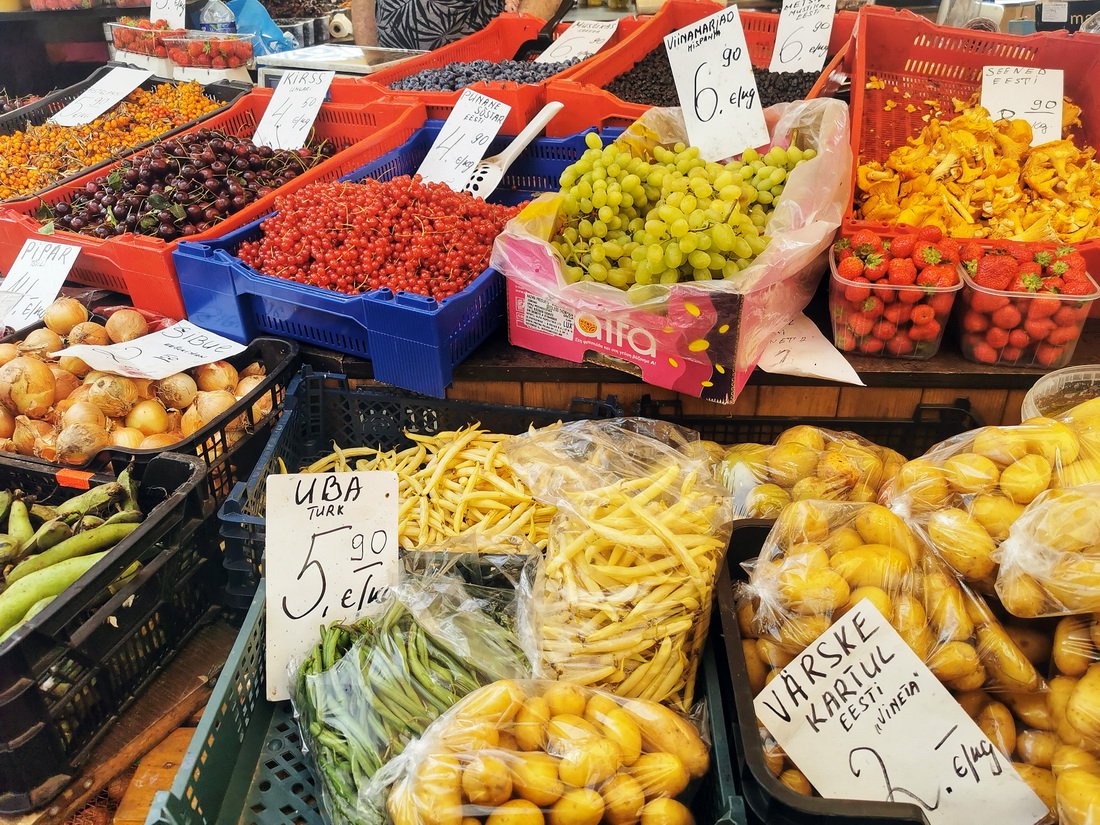
Summer in Tallinn means berries, vegetables, and colours at every market — and prices that still make sense.
Tallinn isn’t the cheapest city in the Baltics — but it’s definitely doable. Think slightly pricier than Latvia or Lithuania, but still much cheaper than Stockholm or Copenhagen. And many of the best experiences here? Completely free.
Accommodation:
- Rooms with a shared bathroom: from €40/night
- Rooms with a private bathroom: usually from €50
- Hostels: dorm beds from €17, private rooms from €35
- Mid-range apartments: around €70/night
- High-end stays: from €100 and up
Museums:
Tickets usually cost €8–12, though major ones can be up to €20. Children, students, and families often get discounts — always worth asking.
Food & drink:
- Coffee: €2.50 for an espresso, €4 for a cappuccino
- Café lunch: €7–12
- Sweet bun: under €1
- Bottle of wine: from €6
Groceries:
- Potatoes: €0,5/kg
- Tomatoes: up to €3/kg
- Apples: around €2/kg
- Milk: €1–1.50/litre
- Local cheese: €12–15/kg
- Meat or fish: €5–14/kg
Essentials:
- Painkillers: from €3.50
- Antibiotics: prescription only — even for tourists.
Postcards & Stamps:
- Postcard: ~€1.
- Stamp: €1.30 (Estonia) / €2.60 (international)
🎁 Good news: Many viewpoints, churches, galleries, and even small museums are free or donation-based. Just keep an eye on the opening hours — they can be quirky.
Where to Buy Groceries in Tallinn?
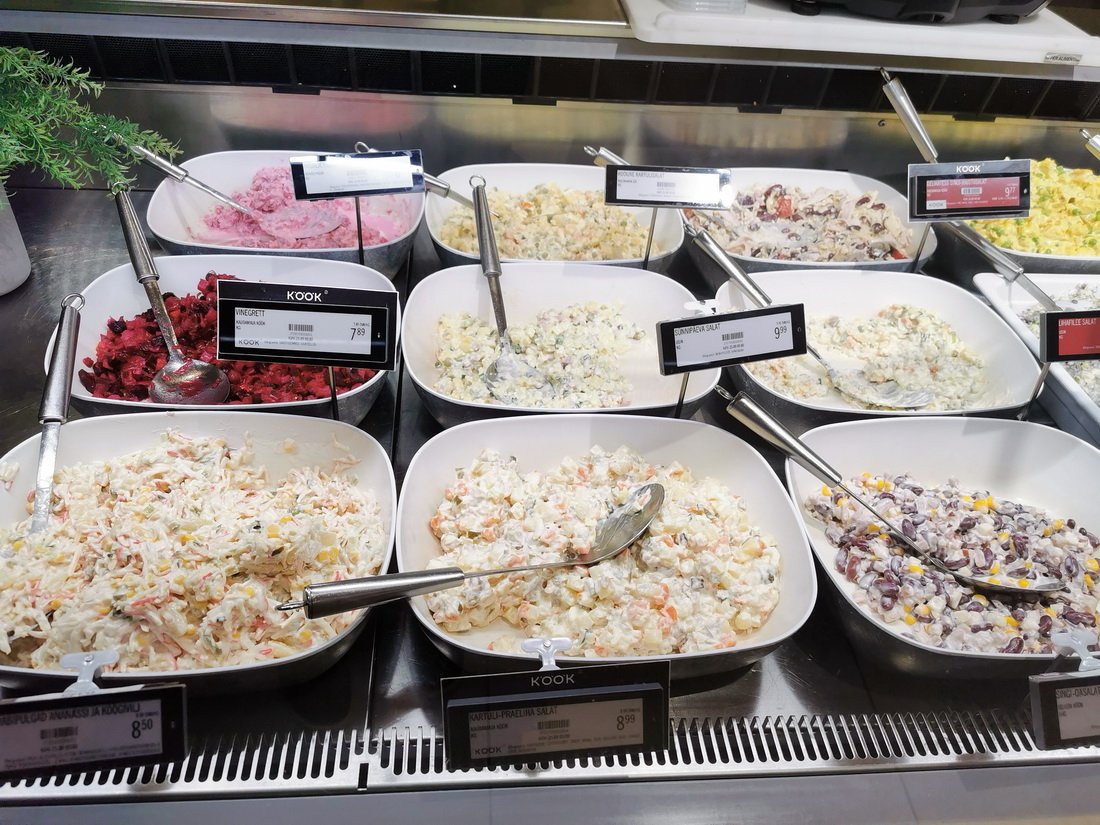
Ready-made salads and meals at the Viru Keskus supermarket — Tallinn’s fast and filling lunch solution.
Tallinn has no shortage of supermarkets — Selver, Prisma, Rimi, Maxima, Lidl. Prices don’t differ wildly, but for the budget-conscious: Lidl and Rimi tend to be cheaper, while Selver leans slightly upscale. All of them stock gluten-free, lactose-free, and vegetarian options.
Need food right now? Head to the Viru Keskus supermarket near the main bus stop. They’ve got a solid selection of ready-to-eat meals — roast chicken, sushi, salads, pastries, smoothies — quick, decent, and no cooking required.
For something more atmospheric, walk over to Balti Jaama Turg (just 5 minutes from the Old Town). Fresh berries, veg, smoked fish, caviar, and a dozen food stalls selling everything from dumplings to desserts. Slightly pricier than average, but worth it for the vibe.
Want to shop like a local? Try the Central Market (Keskturg). Simple, unfussy, and full of real-life Tallinn — plus decent prices.
🍴 Wondering what all that smoked fish, rye bread, and mysterious dairy actually tastes like? → Here’s my short guide to Estonian food.
How much time do you need in Tallinn?
Let’s be honest — even one day in Tallinn can be lovely. The Old Town is compact, and you can see a lot just by wandering. But if you’ve got a bit more time, here’s how it plays out:
🕰️ 1 day
Enough for: cobblestones, spires, coffee, and a decent number of wow moments.
You’ll mostly stick to the Old Town, maybe squeeze in a museum or two.
🕰️ 3 days
The sweet spot. You can explore the centre properly, visit Kadriorg or Telliskivi, climb a church tower, eat well, and actually pause to enjoy it all.
🕰️ 5–7 days
Perfect if you’re curious. Add in a few day trips — to the islands, the seaside, or even Helsinki. Slow mornings, long dinners, and the chance to spot Tallinn’s quieter magic.
💡 Tallinn doesn’t rush you — and you don’t have to rush it either.
Getting Around Tallinn by Bus and Tram
Tallinn is easy to reach — and even easier to navigate once you’re here.
The airport sits just 4 km from the centre. It’s small, calm, and well-organised, with cafés, phone chargers, a kids’ play area, and a water fountain for refilling your bottle. Getting into town takes about 15 minutes by bus or taxi.
You can also arrive by ferry from Helsinki (2.5 hours) or Stockholm (overnight). Ferries run daily and dock just a short walk from the Old Town.
Buses from Riga are another solid option — comfy, affordable, and easy to book via tpilet.ee or LuxExpress.
Tallinn by bus, tram and taxi
Tallinn is compact — you might not need public transport at all. But if you do, it’s clean, fast, and easy to use.
Schedule:
Buses, trams, and trolleybuses run from around 6:00 to 23:00 (some a bit later). Most lines come every 10–15 minutes during the day.
How to check times:
Use the official Tallinna Transport website or app — or just open Google Maps. It works perfectly in Tallinn and shows real-time arrivals.
How to pay:
The simplest option is to tap your contactless bank card (Visa, MasterCard, Apple/Google Pay) on the validator near the driver. One ride costs €1.50.
You can also get a reusable Ühiskaart (travel card) at any R-kiosk. It costs €3 and can be topped up with credit for single rides, daily passes, or longer options.
Note: drivers don’t sell tickets, so come prepared.
At the stop:
Each stop has a route map and timetable. The screen at the front of the bus or tram shows the route number and final destination — easy to follow, even for visitors.
Ordering a Taxi in Tallinn
The easiest option is Bolt — Estonia’s homegrown ride-hailing app. Works just like Uber, supports English, and lets you pay by card or cash. Prices vary by demand and time, but are generally low:
- Airport → Old Town: ~€7
- Bus station → Old Town: from €4.50
You can also schedule rides in advance.
📱 Bolt app: Android | iOS | bolt.eu
Prefer to call? Companies like Tallink Takso, Amigo Takso, and Forus Takso are reliable. Just confirm the fare before the ride.
Best Day Trips from Tallinn
Tallinn is lovely — but if you have an extra day or two, Estonia has plenty more to offer. Thanks to excellent public transport and short distances, you can hop on a bus, train, or ferry and be somewhere completely different by lunchtime.
Here are some of my favourite day trips, each with its own mood and tempo:
For city lovers
• Tartu – Estonia’s university town: street art, cafés, river walks, and brainy charm.
• Haapsalu – Seaside, swans, and a romantic castle ruin. Feels like a Wes Anderson set with better pastries.
• Narva – The edge of the EU, quite literally. Two castles — one Estonian, one Russian — stare each other down across the river.
For island energy
• Naissaar – Wild and forested, with Cold War relics and beaches where you might be the only one around.
• Aegna – Peaceful and close. Great for picnics, mushrooms, and quiet walks.
• Prangli – My favourite of the three. Proper village life, sea air, and a chapel with a wooden chandelier.
🛳️ See more: Prangli day trip guide → | Naissaar trip notes →
For something different
• Kuremäe Convent – Estonia’s only active Orthodox monastery, deep in the forest. You’re free to visit the grounds and enter the church.
• Lake Peipus – Try it in winter, when people sit on frozen water hoping for a fish to nibble. Not warm, but very memorable.
• Viljandi – Medieval castle ruins and hilly streets in the middle of Estonia. Slightly poetic. Often foggy.
If you’ve got more time, spend a night on Saaremaa, Hiiumaa, or even Kihnu, where traffic signs warn of dancing grandmothers. Yes, really.
🚌 Want full details? Here’s my guide to 9 easy day trips from Tallinn →
How to travel around Estonia
Estonia is small — which makes it perfect for day trips and short escapes. Most towns and nature spots are under 4–5 hours from Tallinn, and public transport is reliable, modern, and easy to use. You don’t need a car unless you’re chasing remote beaches or island windmills.
By bus
Long-distance buses connect Tallinn with pretty much everywhere: Tartu, Narva, Pärnu, Viljandi, and more. Most buses are comfortable and clean, with free Wi-Fi, power sockets, and sometimes even seatback screens. A one-way ticket usually costs €10–15.
Buses leave from Tallinn Bus Station (Tallinna Bussijaam) at Lastekodu 46 — a small, tidy terminal halfway between the Old Town and the airport. There’s a ticket counter, a minimarket, a café, and luggage lockers (€1–3/day depending on size). It’s open daily from 6:00 to 1:00.
⏱️ Buses usually pull in about 15 minutes before departure. Check your platform number on the screen inside.
By train
Trains in Estonia are bright orange — which explains the local nickname “carrots.” And the nickname fits: they’re fast, friendly, and comfy. Clean carriages, big windows, Wi-Fi, and a quiet countryside view all the way.
Rush hours (early morning and late afternoon) can get a bit packed, so go off-peak if you can.
Tallinn’s main station, Balti jaam, is just outside the Old Town. It’s compact and easy to figure out — no underground mazes or endless platforms. There’s even a big Selver supermarket right next door, in case you need snacks or socks before departure.
🔗 Check schedules and tickets on the Elron website →
Is Tallinn safe?
Yes — Tallinn is a very safe city, day or night. Estonia has a low crime rate, and you can walk around comfortably, even in quieter areas or after dark.
That said, it’s always smart to stay aware of your things, especially on public transport or in crowded bars. Pickpocketing is rare, but it happens — like anywhere with tourists.
Solo female travellers usually feel safe here too. Just use the usual common sense: avoid walking home alone after drinking, and be cautious with anyone who gets too friendly too fast.
One local detail worth knowing: in Estonia, you’re legally required to wear a reflector on your clothing or bag after dark. They cost €1–2 and are sold at R-kiosks, post offices, and supermarkets. Locals wear them without a second thought — and yes, they really do help drivers see you.
Best Time to Visit Tallinn
Tallinn is beautiful all year — and unpredictable in the best (and worst) way. Sunshine, sleet, wind, and fog often take turns on the same afternoon. Still, if you’re wondering when to visit, there are two golden windows: May to early October, and mid-December through New Year’s.
Here’s what each season actually feels like:
Spring (March–May)
March is still winter — snow, cold wind, and that fifty-shades-of-grey sky. But April brings the first crocuses, and by May, the city blooms: lilacs, apple blossoms, flower beds tucked between medieval walls. People start switching to lighter coats (cautiously).
May is wonderful. Long days, soft sunlight, near-empty museums. Mornings are crisp, afternoons café-perfect. Bring layers — this is still the Baltics.
Summer (June–August)
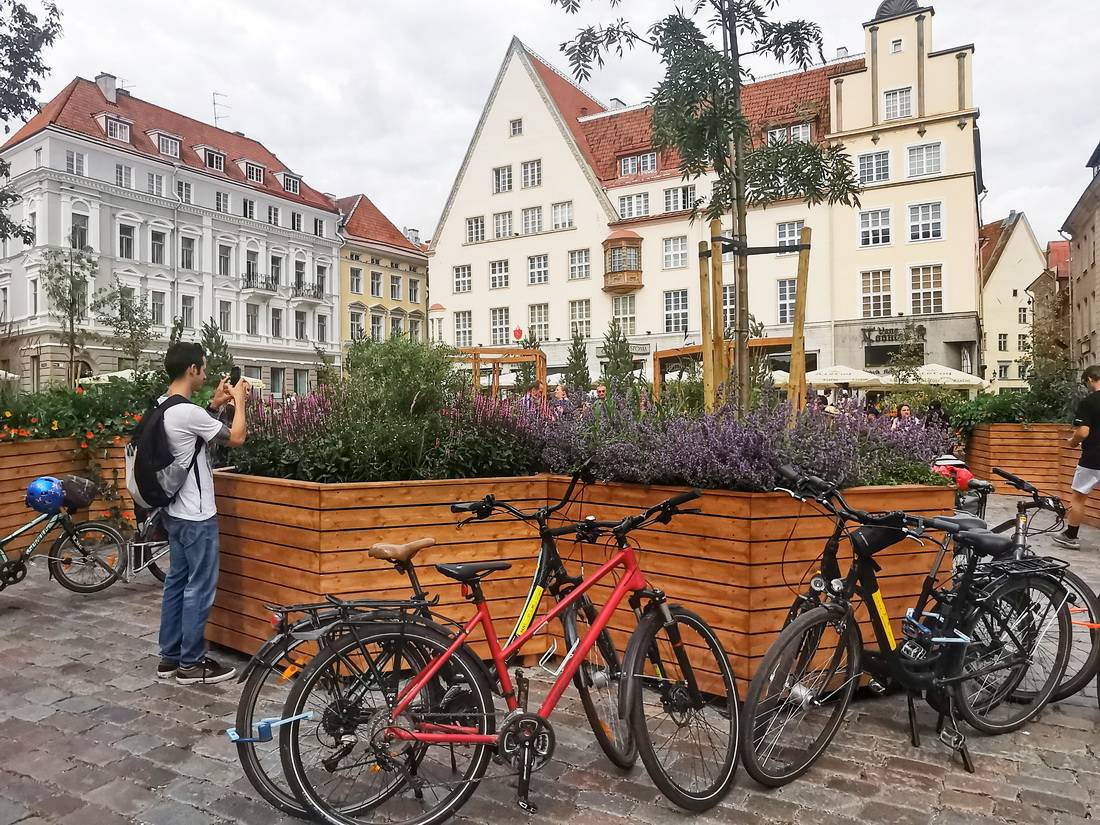
Lush greenery and bright skies in Tallinn in mid-August, with scattered clouds hinting at a summer shower.
Long days, green parks, and outdoor everything. Tallinn’s summer feels both laid-back and full of surprises.
Temperatures usually hover around 19–23°C, though it can swing both ways. One week it’s T-shirt weather, the next you’ll wish you brought a hoodie. July is the most reliable for warmth and sunshine. August tends to bring more thunderstorms — not every year, but often enough to keep an umbrella in your bag.
From late May to late June, you’ll get the famous white nights, when it barely gets dark. Midnight feels like early evening, and the city hums with that slightly surreal energy of endless light.
Terraces overflow, ice cream melts too fast, and even the stone walls of the Old Town seem to breathe a little easier. It’s Tallinn at its most sociable.
Autumn (September–November)
September feels like summer’s afterparty — golden, mellow, and a bit wistful. Leaves turn amber, the light grows softer, and parks fill with people making the most of the last dry days. The best of the foliage usually hits around 20 September to 7 October — Tallinn’s brief but beautiful golden autumn.
October brings wind, rustling leaves, and that unmistakable “maybe I should start baking again” feeling. It’s perfect for long walks, hot drinks, and peeking into galleries or cosy museums.
By November, the city shifts gear. The days grow short, the air turns damp, and the colour palette goes full Nordic noir. It rains often, the sky is mostly grey, and daylight ends before you finish your coffee. But — it’s quiet, it’s cheaper, and the Christmas lights start creeping in by the end of the month.
Bring waterproof shoes and low expectations for sunshine. You’ll be fine.
(Still unsure? Here’s what Tallinn in November really feels like →)
Winter (December–February)
Cold. Sometimes very cold. –20 °C isn’t unheard of, though in recent years, most winters have hovered just above or below freezing. Slush is more common than snowstorms — but when it does snow, Tallinn looks like a postcard.
From late November, the Christmas market in Town Hall Square lights up the Old Town. The smell of almonds, the glow of lanterns, the frost on cobblestones — it’s real, it’s festive, and it’s worth packing your warmest coat.
Sunset around 15:00. But the fairy-tale factor? Maximum.
(Wondering what it’s really like? Here’s my post about Tallinn at Christmas and New Year →)
Where to Stay in Tallinn: Hotels, Hostels and More
Tallinn fits all budgets — from dorm beds to boutique hotels, with plenty of cosy, design-forward options in between. The best area to stay? In or near the Old Town. You’ll be close to everything, and the cobblestone charm is hard to beat.
Just one note: inside the Old Town, some streets can get noisy in summer. Even with closed windows, you might hear midnight laughter and clinking glasses — so check reviews if you’re a light sleeper.
Luxury
Hotel Regent Tallinn
Set in one of the oldest buildings in Europe (really), this is medieval charm meets modern comfort. Some rooms have views of St. Olaf’s Church so close you could almost touch it. Small spa, peaceful vibe, perfect location.
Schlössle Hotel
An elegant townhouse tucked just off Town Hall Square. Plush armchairs, thick drapes, and that quiet “someone really thought about this” kind of luxury.
Swissotel Tallinn
Not in the Old Town — but if you like your skyline with your sauna, this is it. Floor-to-ceiling windows, great breakfast, small pool. Excellent for a stylish city stay.
Spa hotels
In Tallinn, “spa hotel” often means access to saunas, pools, and hot tubs — no millionaire status required.
Metropol Spa Hotel
Stylish and central (in the Rotermann Quarter), this four-star spot has sleek rooms and a full spa zone. Entry is included in some rates, or available for a small fee.
Mid-Range
L’Ermitage Hotel
Quiet, well-designed, and a short walk from the Old Town. Some rooms even overlook the medieval skyline. Underrated and excellent value.
Palace Hotel
Classic style near Freedom Square. Calm, elegant, with a small spa and gym. A five-minute stroll to the centre, and great for travellers who like comfort with quiet.
Citybox Tallinn
Modern, minimal, and budget-friendly — with cheerful design and self-check-in. Just 10 minutes from the Old Town and near the ferry terminals.
Hestia Hotel Kentmanni
A modern stay in a quiet corner — close enough to the Old Town (1 km) but away from crowds. Some rooms have balconies. Spa included.
Popup Living Kakumäe
A new seaside hotel about 7 km from the city centre. Quiet air, Nordic simplicity, and rooms that smell faintly of pine and fresh linen. Feels more like a retreat than a city stay. Offers both regular rooms and studios with kitchens.
Apartments
Thomas’ Home – Trendy, Central & Balcony
Stylish, peaceful, and surprisingly central. Located in a new building between the Old Town and Kadriorg. On sunny mornings, you can sip coffee on the balcony and watch trams glide by. Modern kitchen, elevator, and a calm courtyard — ideal for longer stays.
Jakobi Guest Apartment
A quiet, no-frills stay just a short walk from the Central Market and bus station. Comfortable and well-equipped, with a full kitchen, washing machine, and good Wi-Fi. Feels more like a local corner than a tourist stop — especially if you enjoy slow mornings and market walks.
Budget
Fat Margaret’s Hostel
A long-time favourite with travellers for a reason. Just outside the Old Town walls and close to the ferry terminal, it offers dorm beds and private rooms, plus a sauna, small indoor pool, and communal kitchen. Friendly vibe, good coffee, and plenty of space to unwind after a day on the cobblestones.
Imaginary Hostel
Right in the centre and steps from all the sights. Bunk beds with individual lights and charging ports, a basic kitchen, and a cheerful, no-fuss atmosphere. Great for solo travellers who want to be in the middle of it all — without spending it all.
Do People Speak English in Tallinn?
Yes — and often surprisingly well. Estonian is the official language (closely related to Finnish), and many locals also speak Russian. But in Tallinn, English is widely spoken — especially by younger people, museum staff, and anyone working in hospitality.
Hotels, restaurants, and public transport? No problem. Most menus, signs, and announcements are in English too.
The only place you might get slightly confused? Supermarkets. Food packaging is often just in Estonian — but don’t worry, here’s a quick cheat sheet:
🛒 Useful Words for Shopping
Basics
Avatud — Open
Suletud — Closed
Pood / Kauplus — Shop
Food & Drinks
Piim — Milk
Vesi — Water
gaseerimata — still
gaseeritud/gaasiga — sparkling
Õlu — Beer
Kala — Fish
Kana — Chicken
Hapukoor — Sour cream
Jäätis — Ice cream
Dietary Labels
Gluteenivaba — Gluten-free
Laktoosivaba — Lactose-free
Suhkruta — Sugar-free
Taimetoit — Vegetarian
Vegan — Vegan
What to Buy in Tallinn: Souvenirs, Snacks and Gifts
Sure, you’ll find the usual fridge magnets and Viking mugs — but Tallinn has more up its sleeve. If you’re after something with a bit of charm (or flavour), here’s what to look out for:
🧶 Handcrafted and wearable
Estonia’s rich folk traditions live on in woollen mittens, scarves, and patterned socks — often handmade and warm enough for real winters. Expect to pay around €40–50 for a quality pair of mittens. They last, they’re beautiful, and yes, you’ll get compliments.
You’ll also find traditional wooden toys, hand-forged ironwork, ceramics, and silver jewellery in Old Town boutiques and craft fairs.
🍫 Edible classics
Kalev chocolate is everywhere — but for proper gifts, visit the Kalev shop in Rotermanni (Roseni 7). You’ll find elegant boxes, unusual flavours, and charming old-school wrappers. Their marzipan (especially the painted kind) is an Estonian classic — sweet, soft, and giftable.
🥃 Liquid memories
Vana Tallinn is Estonia’s signature liqueur — sweet, spiced, and very drinkable. Made with rum, citrus, and cinnamon, it’s perfect in coffee or over ice cream. A 0.5 L bottle starts around €10 in most supermarkets.
🧂 Quirky local picks
Some souvenirs raise eyebrows at customs — in a good way. Keep an eye out for:
- Spicy sprats in oil (yes, they’re tasty)
- Bright yellow mustard in a tube
- Raw Estonian honey in tiny jars
- Juustupats — braided, salty local cheese (perfect with beer)
You’ll find most of these in supermarkets or at Balti Jaama Turg, where browsing is half the fun.
📍 Marking Your Spot
Where you stay can shape how you see a city — and Tallinn is a great example of that. Whether you’re sipping coffee under medieval towers or waking up next to a pine forest, your base will color the way you remember the place. I’ve tried to offer options that match different moods, seasons, and travel styles — with a soft spot for places that feel like they belong here, not just anywhere.
Wherever you land, I hope Tallinn will surprise you a little — with its calm and contrasts, sea air and slippery cobblestones, misty mornings and glowing rooftops. And I hope this guide helped you find not just a bed, but a story to carry home.
